Contents
Manual 5
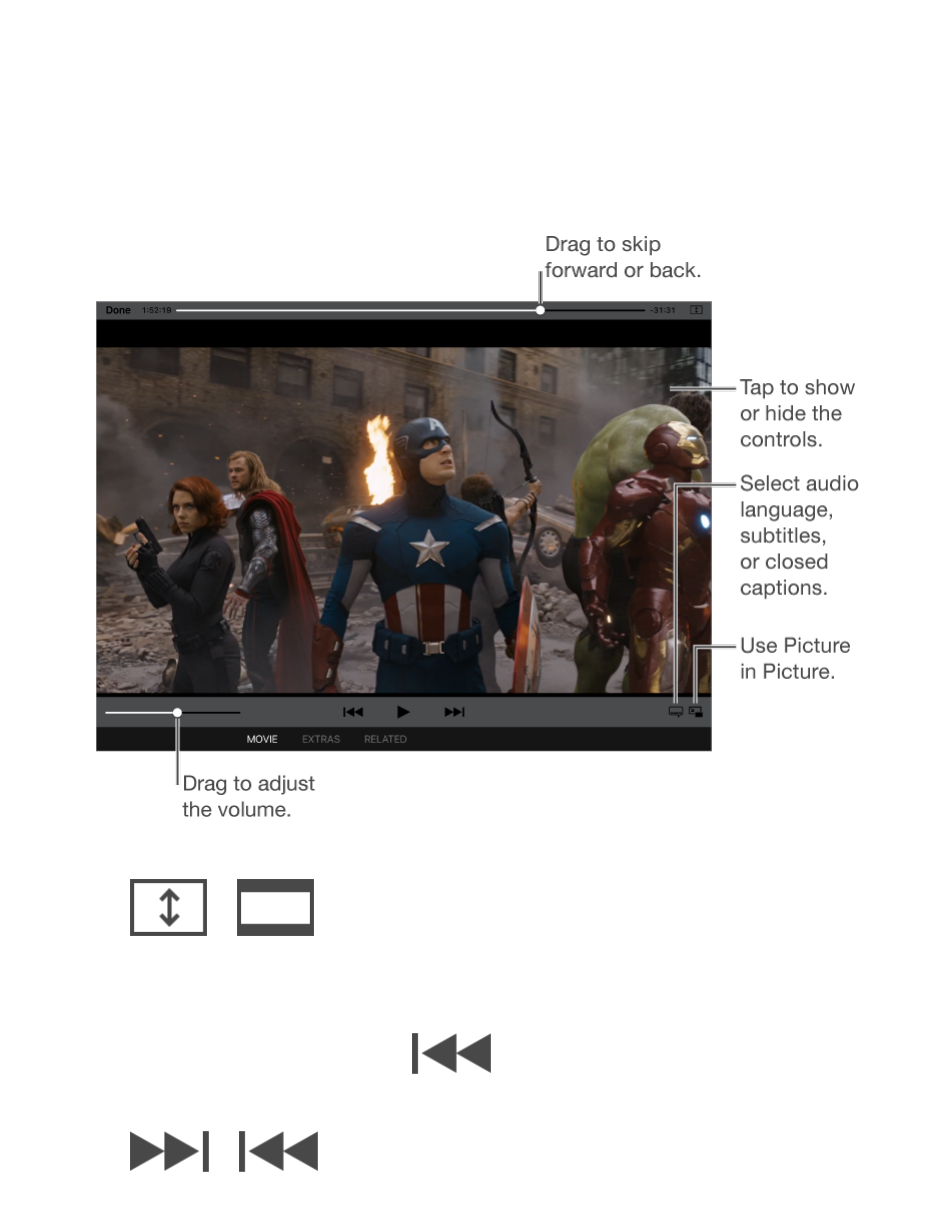
sync a deleted video back to iPad, set iTunes to not sync the video. See Sync
with iTunes (on page) .
Important: If you delete a rented movie from iPad, it’s deleted permanently and
cannot be transferred back to your computer.
Control playback
Scale the video to fill the screen or fit to the screen.
Tap or . Or double-tap the video. If you don’t see the
scaling controls, your video already fits the screen perfectly.
Start over from the beginning.
If the video contains chapters, drag the playhead along the scrubber bar all the
way to the left. If there are no chapters, tap .
Skip to the next or previous chapter.
Tap or . You can also press the center button or
equivalent on a compatible headset two times (skip to next) or three times (skip
Apple Confidential
143
DRAFT

to previous).
Rewind or fast-forward.
Touch and hold or . Or drag the playhead left or right.
Move your finger toward the bottom of the screen as you drag for finer control.
Select a different audio language.
If the video offers other languages, tap , then choose a language
from the Audio list.
Show subtitles or closed captions.
Tap . Not all videos offer subtitles or closed captions.
Customize the appearance of closed captions.
Go to Settings > General > Accessibility > Subtitles & Captioning.
See closed captions and subtitles for the deaf and hard of hearing.
Go to Settings > General > Accessibility > Subtitles & Captioning, then turn on
Closed Captions + SDH.
Watch the video on a TV.
Tap . For more about AirPlay and other ways to connect, see AirPlay
(on page) .
Multitask with Picture in Picture.
When watching a video, press the Home button or tap . Your video
screen scales down to a corner of your display so you can see the Home
screen and open other apps. To return to the video, tap in the
small video window. For more information, see Picture in Picture (on page) .
Videos settings
Go to Settings > Videos, where you can:
Choose where to resume playback the next time you open a video
Choose to show only videos that are downloaded to this device
Log in to Home Sharing
Apple Confidential
144
DRAFT
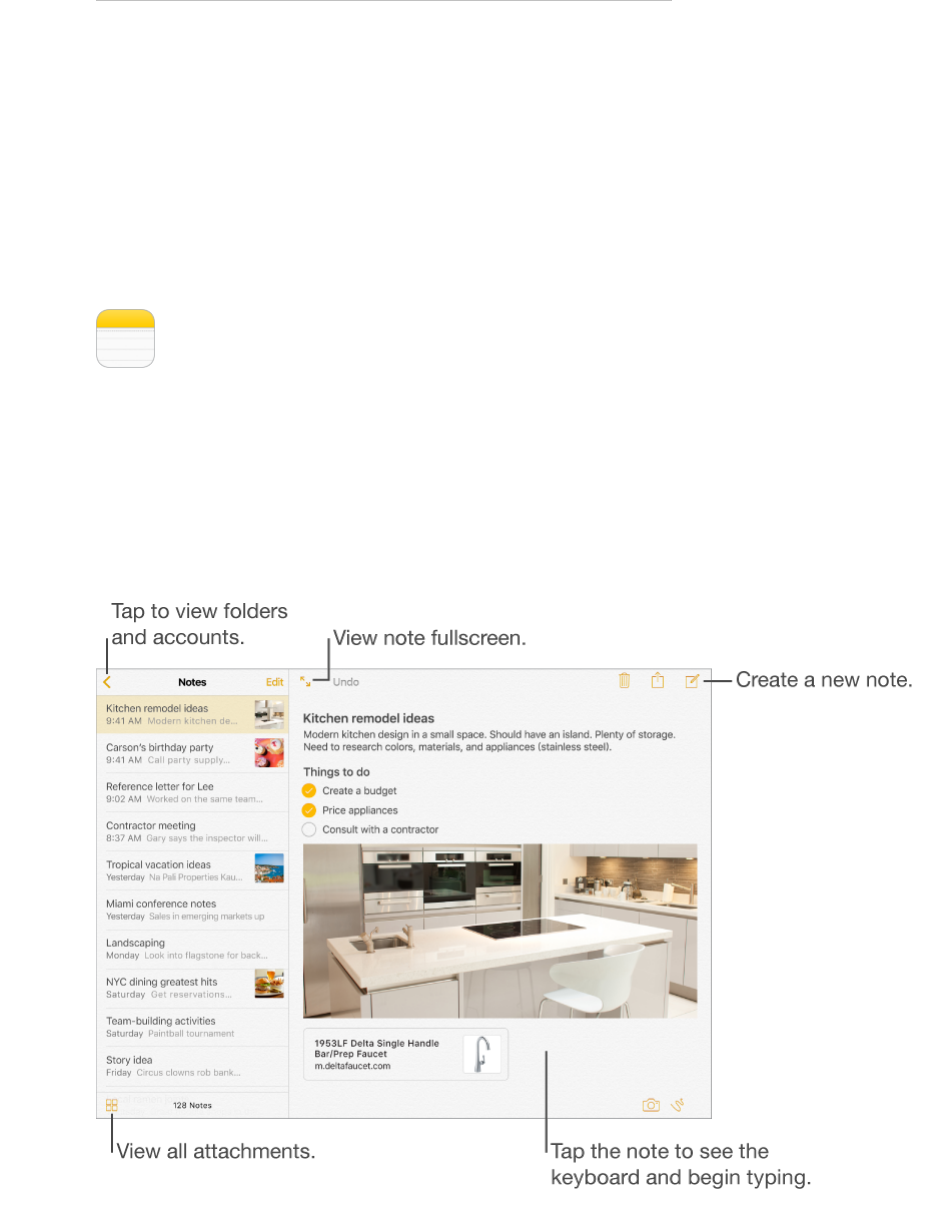
Notes
Notes at a glance
With Notes you can jot down important information, add attachments—like
photos, web links, or maps—sketch ideas, and keep things organized. When
you create notes in your iCloud account, they’re available on your other iOS
devices, Mac computers, and iCloud.com.
Apple Confidential
145
DRAFT
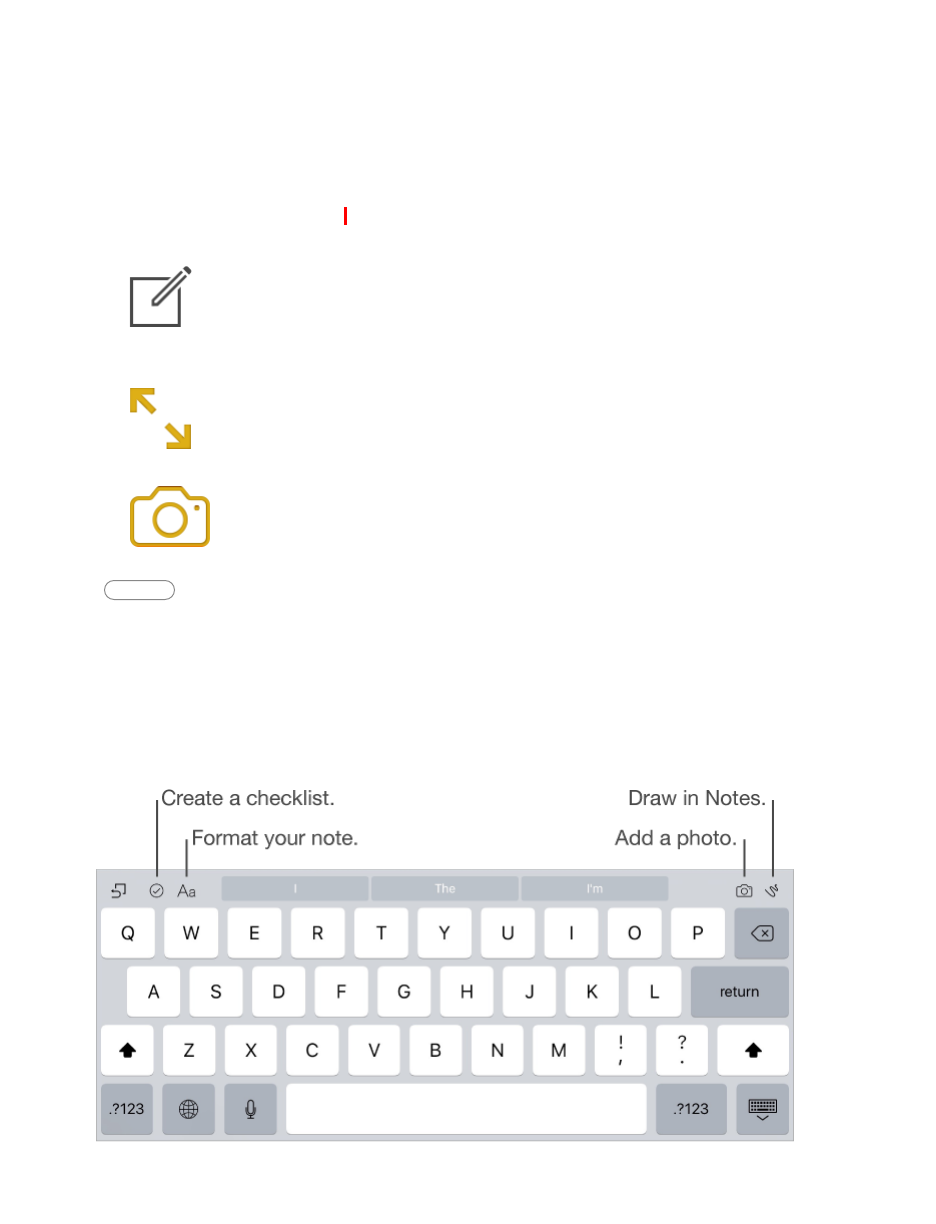
Set up notes.
Go to Settings > iCloud, then turn on Notes. Your iCloud notes appear on all
your iOS devices and Mac computers that use the same Apple ID.
Note: If you’ve been using an older version of Notes, you may need to
upgrade your iCloud notes to use all the new features—sketching, checklists,
paragraph styles, and more. To upgrade, tap the Upgrade button (next to your
iCloud notes account in the upper-left corner of Notes). For more information
about upgrading notes in your iCloud account, including how it affects using
Notes on your other devices, see support.apple.com/HT204987.
Create a new note.
Tap , then tap your note to bring up the keyboard. The first line of the
note becomes the note’s title.
See just the note.
Tap or turn iPad to portrait orientation.
Add a photo or video to your note.
Tap . Take a new photo or video, or tap Photo Library to select and
add existing photos and videos.
Ask Siri Say something like: “Create a new note.”
Format notes
With upgraded notes, you can create checklists, change paragraph styles, and
add attachments.
Start a checklist.
Apple Confidential
146
DRAFT

Tap a line in your note, then tap . Tap again to remove the
checklist format. Type the task. Tap the empty checklist circle to mark your task
complete.
Change the paragraph style of a line.
Tap a line in your note, tap , then select the style.
Set a default formatting style for the first paragraph.
Go to Settings > Notes, then tap New Notes Start With.
Add an attachment.
When you’re in another app and find something (like a location in the Maps app
or a web page in Safari) that you want to add to one of your notes, tap Share or
, then tap Notes. You can create a new note, or add the attachment to
an existing one.
Create a sketch
Sometimes you may want a sketch to help you capture an idea or plan. Start a
sketch using the pencil, marker, or pen tool. Switch to the eraser if you make a
mistake.
Note: The sketching feature is available with upgraded notes on iPad
(4th generation), iPad Air (all models), and iPad mini 2 and later.
Apple Confidential
147
DRAFT
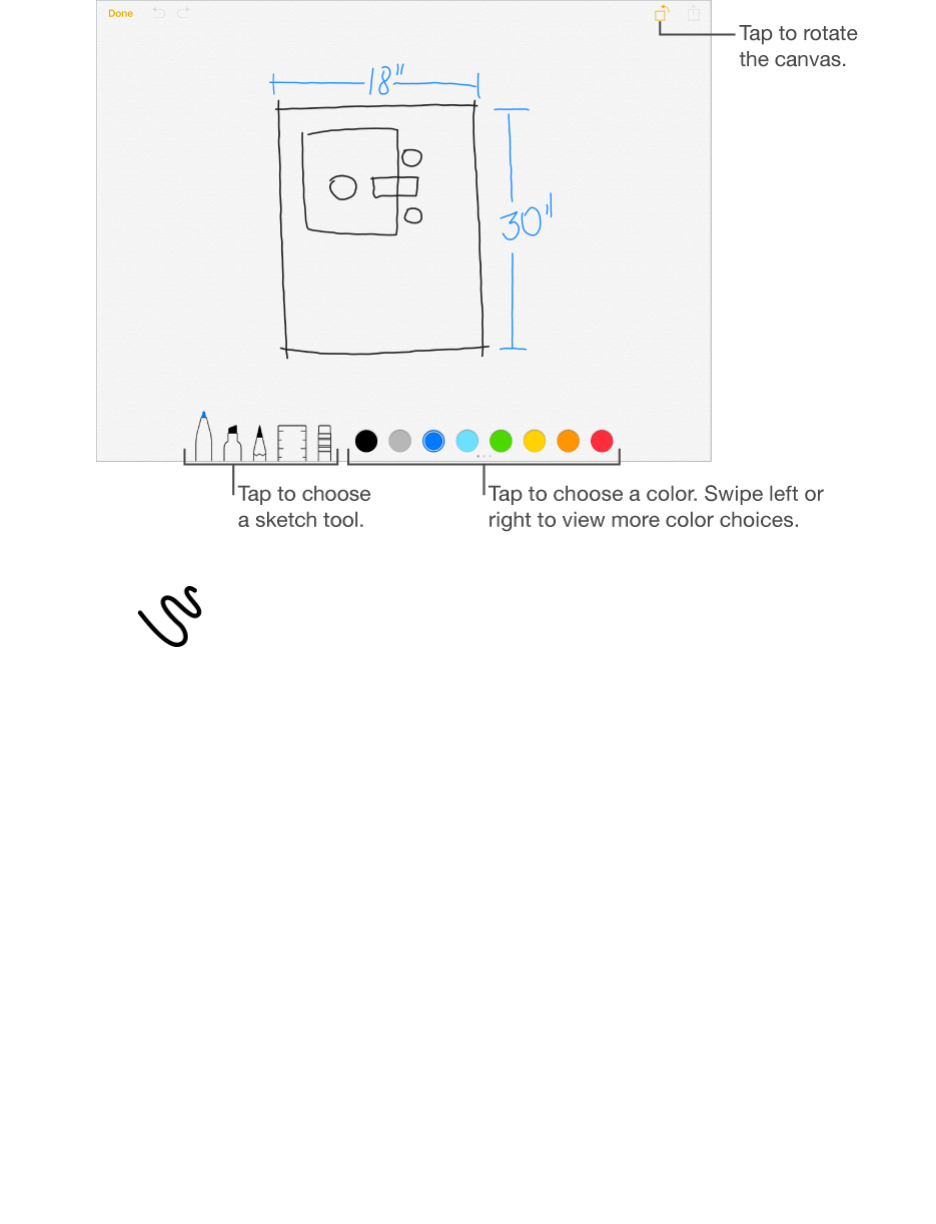
Sketch in your note.
Tap , use your finger to sketch, then tap Done. Your sketch appears
in your note. Tap the sketch to edit it.
View more color choices.
Swipe the color palette left or right to see more colors.
Draw straight lines.
Tap the ruler tool to make it appear on your canvas. Draw a line along the edge
of the ruler. Tap the ruler tool again to make it disappear.
Move the ruler without changing its angle.
Drag the ruler with one finger.
Adjust the angle of the ruler.
Touch and hold the ruler with two fingers, then rotate your fingers.
Mask a part of your sketch.
Place the ruler along the edge of the area you want to cover, then start your
sketch. Draw lines that start away from the ruler’s edge, then come toward it.
Hide the toolbar.
Swipe the toolbar down to hide it and see just the tool you’re using. Tap the
tool you’re using to see the entire toolbar again.
Zoom in.
Pinch open so you can sketch the details—then pinch closed to zoom back
out. Drag two fingers to navigate after you’ve zoomed in.
Apple Confidential
148
DRAFT

Start over.
Touch and hold the eraser tool, then tap Erase All.
Organize and share notes
Share or print a note.
Tap at the top of the note. For more information about sharing, see
Share from apps (on page) . For more information about printing, see AirPrint (on
page) .
Search for a note.
Scroll to the top of a list of notes to reveal the search field, then tap the field and
type what you’re looking for.
Delete a note.
Tap , or swipe left over the note in the notes list.
Recover deleted notes.
Open the Recently Deleted folder. Tap the note you want to keep, tap in the
note, then tap Recover (upgraded notes only).
Search for a specific attachment.
Tap in the lower-left corner of the notes list to see sketches, photos,
links, documents, and other attachments you’ve added to your notes. To go to
the note with the attachment, touch and hold the thumbnail of the attachment,
then tap Go to Note (upgraded notes only).
Create a folder to organize your notes.
Tap New Folder (at the bottom of the Folders list), then name your folder
(upgraded notes only).
Move notes from one folder or account to another.
Tap Edit in the upper-right corner of the notes list, tap the notes you want to
move, tap Move, then choose the folder or account. To move all your notes
from one folder or account to another, tap Edit in the upper-right corner of the
notes list, then tap Move All.
Use notes in multiple accounts
View and edit notes from other accounts (such as Google, Yahoo!, or AOL).
Go to Settings > Mail, Contacts, Calendars, then turn on Notes for the account.
These notes appear in Notes on all your other iOS devices and Mac computers
that are also signed in to that account.
Note: Notes from these accounts can’t use many of the features in upgraded
Apple Confidential
149
DRAFT

notes.
Turn on an On My iPad account.
Go to Settings > Notes, then turn on On My iPad. Notes in this account appear
only on your iPad.
Choose the default account for new notes you create with Siri.
Go to Settings > Notes.
See all folders in an account.
Tap at the top of a list of notes.
Reminders
Reminders lets you keep track of all the things you need to do.
Reminders at a glance
Reminders lets you keep track of all the things you need to do.
Apple Confidential
150
DRAFT
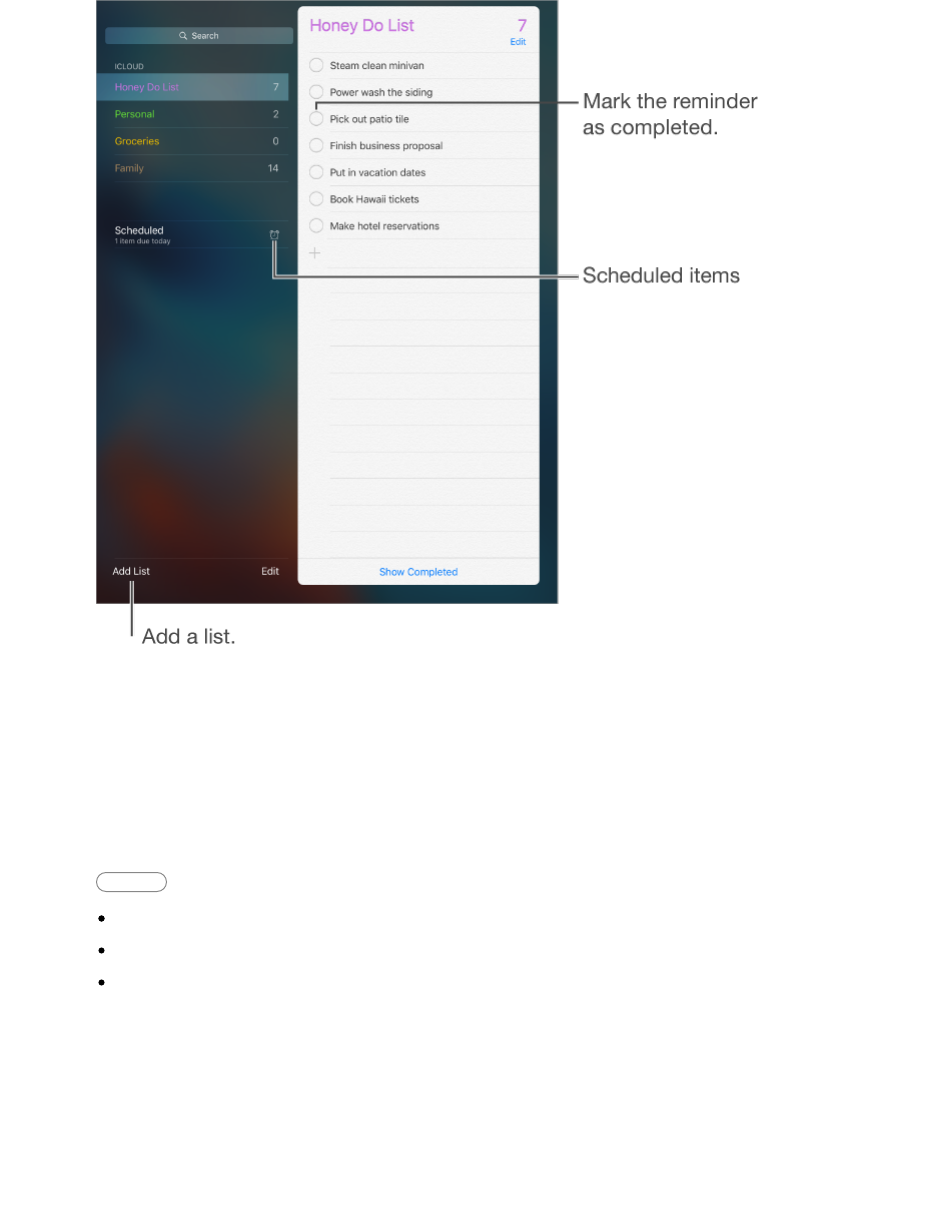
Add a reminder.
Tap a list, then tap a blank line.
Share a list.
Tap a list, then tap Edit. Tap Sharing, then tap Add Person. The people you
share with also need to be iCloud users. After they accept your invitation to
share the list, you’ll all be able to add, delete, and mark items as completed.
Family members can also share a list. See Family Sharing (on page) .
Ask Siri Say something like:
“Remember to take an umbrella”
“Add artichokes to my groceries list”
“Read my work to-do list”
Delete a list.
While viewing a list, tap Edit, then tap Delete List. All of the reminders in the list
are also deleted.
Delete a reminder.
Swipe the reminder left, then tap Delete.
Change the order of lists or reminders.
Apple Confidential
151
DRAFT
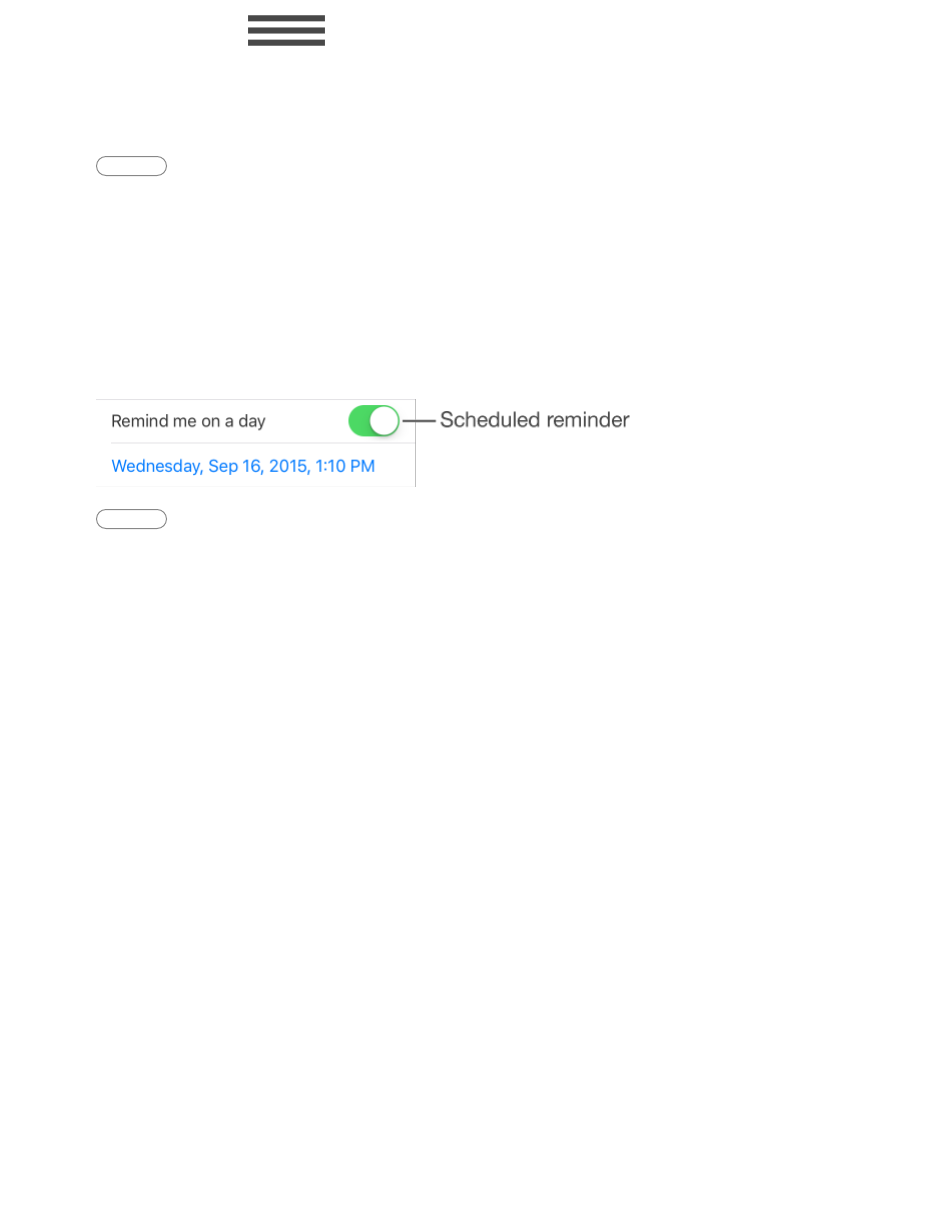
Tap Edit, then touch and move the item.
What list was that in?
When you enter text in the search field, reminders in all lists are searched by
the reminder’s name.
Ask Siri Say something like: “Find the reminder about milk.”
With OS X Yosemite or later, you can hand off reminders you’re editing between
your Mac and iPad. See About Continuity features (on page) .
Scheduled reminders
Scheduled reminders notify you when they’re due.
Ask Siri Say something like: “Remind me to take my medicine at 6 a.m.
tomorrow.”
Schedule a reminder.
Swipe a reminder to the left, tap More, then turn on “Remind me on a day.” Tap
Alarm to set the date and time. Tap Repeat to schedule the reminder for
regularly occurring intervals.
Don’t bother me now.
You can turn off Reminders notifications in Settings > Notifications. To silence
notifications temporarily, turn on Do Not Disturb.
Location reminders
On iPad Wi-Fi + Cellular models, Reminders can alert you when you arrive at or
leave a location.
Apple Confidential
152
DRAFT
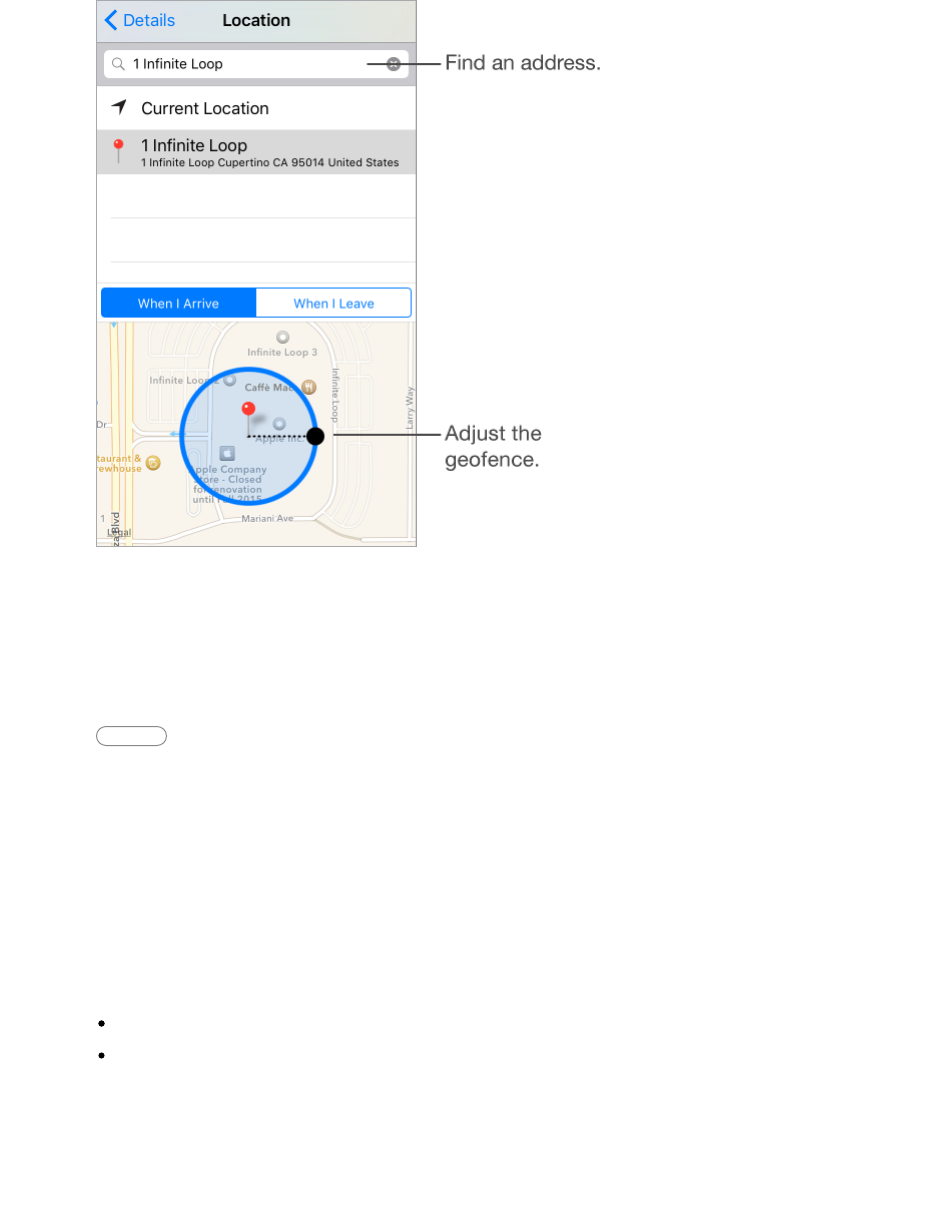
Be reminded when you arrive at or leave a location.
Swipe a reminder to the left, tap More, then turn on “Remind me at a location.”
Tap Location, then choose a location from the list or enter an address. After you
define a location, you can drag to change the size of the geofence on the map,
which sets the approximate distance at which you want reminded. You can’t
save a location reminder in Outlook or Microsoft Exchange accounts.
Ask Siri “Remind me to stop at the grocery store when I leave here.”
Add common locations to your My Info card.
When you set a location reminder, locations in the list include addresses from
your My Info card in Contacts. Add your work, home, and other favorite
addresses to your card for easy access in Reminders.
Reminders settings
Go to Settings > Reminders, where you can:
Set a default list for new reminders
Sync past reminders
Keep your reminders up to date on other devices.
Go to Settings > iCloud, then turn on Reminders. To keep up to date with
Reminders on OS X, turn on iCloud on your Mac, too. Some other types of
accounts, such as Exchange, also support Reminders. Go to Settings > Mail,
Contacts, Calendars, then turn on Reminders for the accounts you want to use.
Apple Confidential
153
DRAFT

Photo Booth
It’s easy to take a photo with Photo Booth and spice it up with effects.
Take photos
Apple Confidential
154
DRAFT

When you take a photo, iPad makes a shutter sound. You can use the volume
buttons on the side of iPad to control the volume of the shutter sound, or mute it
by setting the Side Switch to silent. See Volume buttons (on page) .
Note: In some regions, sound effects are played even if the Side Switch is set
to silent.
Take a photo.
Aim iPad and tap the shutter button.
Select an effect.
Tap , then tap the effect you want.
Change a distortion effect: Drag your finger across the screen.
Alter a distortion: Pinch, swipe, or rotate the image.
What have you done?
Tap the thumbnail of your last shot. To display the controls again, tap the screen.
Switch between cameras.
Tap at the bottom of the screen.
Manage photos
The photos you take with Photo Booth are saved to your Recently Added album
in the Photos app on iPad.
Delete a photo.
Select a thumbnail, then tap .
Share or copy a photo.
Tap a thumbnail, tap , then tap a share option (Message, Mail, iCloud,
Twitter, or Facebook) or Copy.
View photos in the Photos app.
In Photos, tap Photos, then tap Today, or tap Albums, then Recently Added,
then tap a thumbnail. To see the next or previous photo, swipe left or right. See
View photos and videos (on page) .
Share photos on all your devices.
If you use iCloud Photo Library, you can share your photos with any iOS 8.1 or
later device, Mac with OS X Yosemite v10.10.3 or later, and on iCloud.com using
the same Apple ID. See iCloud Photo Library (on page) .
Upload photos to your computer.
Connect iPad to your computer using the included USB cable.
Mac: Select the photos to upload, then click the Import or Download button
Apple Confidential
155
DRAFT

in iPhoto or other supported photo app on your computer.
PC: Follow the instructions that came with your photo app.
If you delete the photos from iPad when you upload them to your computer,
they’re removed from Photos. You can use the Photos settings pane in iTunes to
sync photos to the Photos app on iPad.
Game Center
Discover new games and share your game experiences with friends around the
world in Game Center.
Game Center at a glance
Game Center lets you play your favorite games with friends who have an iOS
device or a Mac (OS X Mountain Lion or later). You must be connected to the
Internet to use Game Center.
WARNING: For important information about avoiding repetitive motion injuries,
see Important safety information (on page) .
Apple Confidential
156
DRAFT
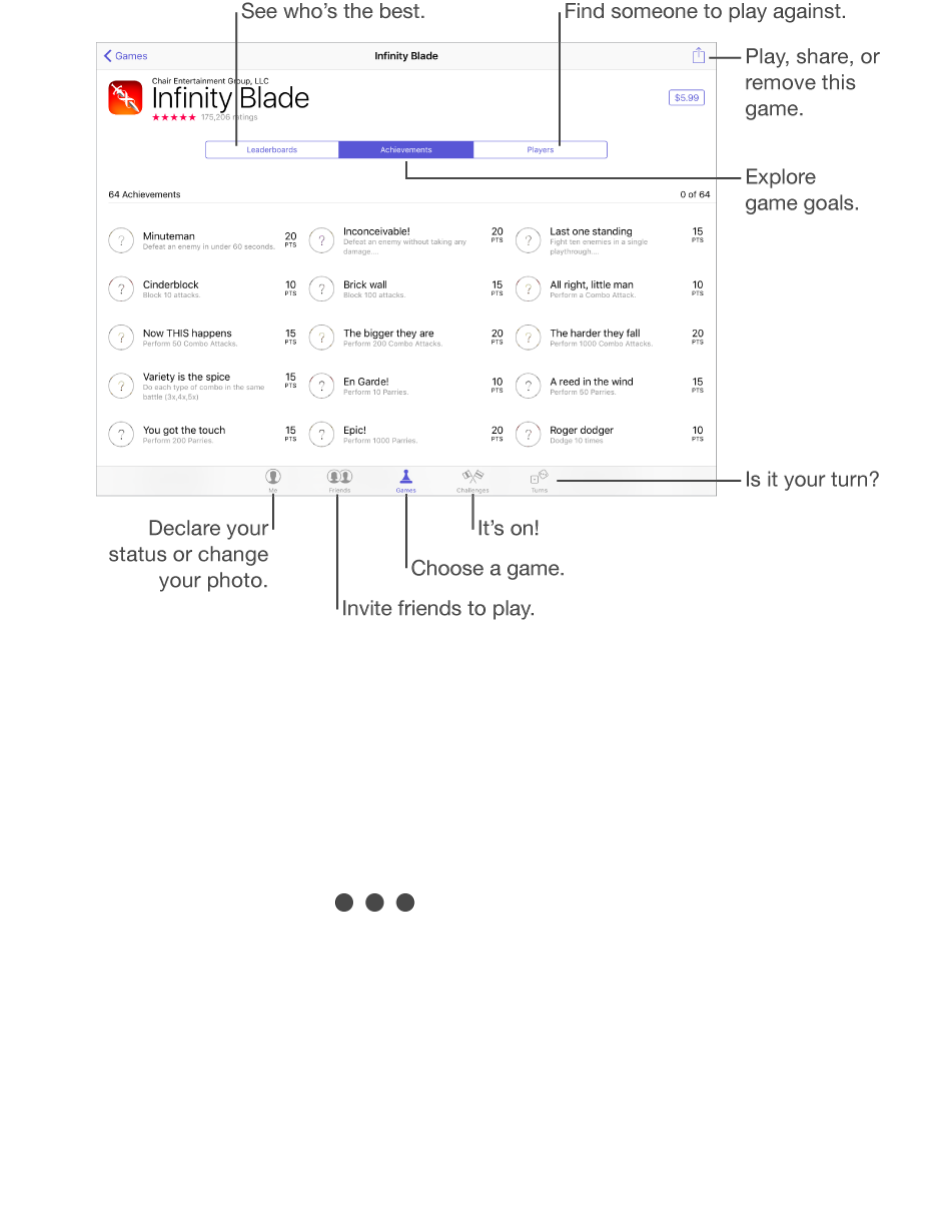
Get started.
Open Game Center. If you see your nickname at the top of the screen, you’re
already signed in. Otherwise, you’ll be asked for your Apple ID and password.
Get some games.
Tap Games, then tap a recommended game, browse for games in the App Store
(look for Supports Game Center in the game details), or get a game one of your
friends has. See Play games with friends (on page) .
Play!
Tap Games, choose a game, tap in the upper right, then tap Play. (If
Play doesn’t appear, the game is not currently installed.)
Sign out?
No need to sign out when you quit Game Center, but if you want to, go to
Settings > Game Center, then tap your Apple ID.
Play games with friends
Invite friends to a multiplayer game.
Apple Confidential
157
DRAFT

Tap Friends, choose a friend, choose a game, then tap in the upper
right. If the game allows or requires additional players, choose the players to
invite, then tap Next. Send your invitation, then wait for the others to accept.
When everyone is ready, start the game. If a friend isn’t available or doesn’t
respond, you can tap Auto-Match to have Game Center find another player for
you, or tap Invite Friend to invite someone else.
Send a friend request.
Tap Friends, tap , then enter your friend’s email address or Game
Center nickname. To browse your contacts, tap . (To add several
friends with one request, type Return after each address.) Or, tap any player you
see anywhere in Game Center.
Challenge someone to outdo you.
Tap one of your scores or achievements, then tap Challenge Friends.
What are your friends playing and how are they doing?
Tap Friends, tap your friend’s name, then tap the Games or Points bubble.
Want to purchase a game your friend has?
Tap Friends, then tap your friend’s name. Tap his or her Games bubble, tap the
game in the list, then tap in the upper right.
Make new friends.
To see a list of your friend’s friends, tap Friends, tap your friend’s name, then tap
his or her Friends bubble.
Unfriend a friend.
Tap Friends, tap the friend’s name, then tap in the upper right.
Keep your email address private.
Turn off Public Profile in your Game Center account settings. See Game Center
settings (on page) .
Turn off multiplayer activity or friend requests.
Go to Settings > General > Restrictions, then turn off Multiplayer Games or
Adding Friends. If the switches are dimmed, tap Enable Restrictions at the top
first.
Keep it friendly.
To report offensive or inappropriate behavior, tap Friends, tap the person’s
name, tap in the upper right, then tap Report a Problem.
Apple Confidential
158
DRAFT

Game Center settings
Go to Settings > Game Center, where you can:
Sign out (tap your Apple ID)
Allow invites
Let nearby players find you
Edit your Game Center profile (tap your nickname)
Get friend recommendations from Contacts or Facebook
Specify which notifications you want for Game Center.
Go to Settings > Notifications > Game Center. If Game Center doesn’t appear,
turn on Notifications.
Change restrictions for Game Center.
Go to Settings > General > Restrictions.
News
News at a glance
News collects all the stories you want to read, from your favorite sources,
based on the topics that interest you most. You can also explore recommended
channels, search for specific channels or topics, and save and share your
favorite stories.
Note: You need a Wi-Fi or cellular connection to read News. News is not
available in all areas.
Apple Confidential
159
DRAFT

Get started with News
The first time you open News, you can personalize it based on your interests.
Add channels and topics.
Open News, then add your preferred channels (or publications) and topics to
your favorites. The stories that appear in your For You feed (your list of stories)
are influenced by your choices.
Seek out additional channels and topics.
Tap Explore to browse suggested channels and topics. Or browse topics such
as Travel, Arts, or Sports by tapping it. To add a channel or topic to your
favorites, tap .
For You
For You presents the best stories from the channels and topics you added to
Favorites.
See what you missed.
The number of new stories in your feed appears next to For You at the top of
the screen.
Get newer stories.
Pull down to refresh the For You feed.
Quickly share, save, or like a story.
Touch and hold a story in your feed, then choose Share Story, Save, or Like.
Read stories
Read a story.
Tap a story to read it. Web stories delivered through an RSS feed show a
preview. To view a story in full, swipe up. To always see the full story, turn off
RSS previews in Settings > News > Show Story Preview.
Read the next story.
Swipe left to read the next story, swipe right to read the previous story. Swipe
from the left edge to return to the story feed.
Tell News what you like.
When viewing a story, tap to like the story. News takes your
Apple Confidential
160
DRAFT

feedback into account for future recommendations.
Share stories.
Tap , then choose a sharing method such as Message, Mail, Twitter, or
Facebook.
Report a concern.
If you believe a story is mislabeled or inappropriate, tap , then tap
Report a Concern.
Find related stories.
Tap the topic tag to see a list of related stories.
Favorites
The channels and topics you select when you first open News appear in
Favorites. Favorites also includes channels and topics you add later.
Browse a channel’s stories.
Tap a channel or publication to see the most recent published stories. Some
publishers also let you browse sections, such as political stories or stories
about food.
Dig deeper into a topic.
Tap a topic to see recent related stories.
Edit your favorites.
Tap Edit, then tap to delete a channel or topic that you no longer
wish to follow.
Search
News keeps track of more than a million topics, which makes it easy to find the
stories that interest you.
Apple Confidential
161
DRAFT
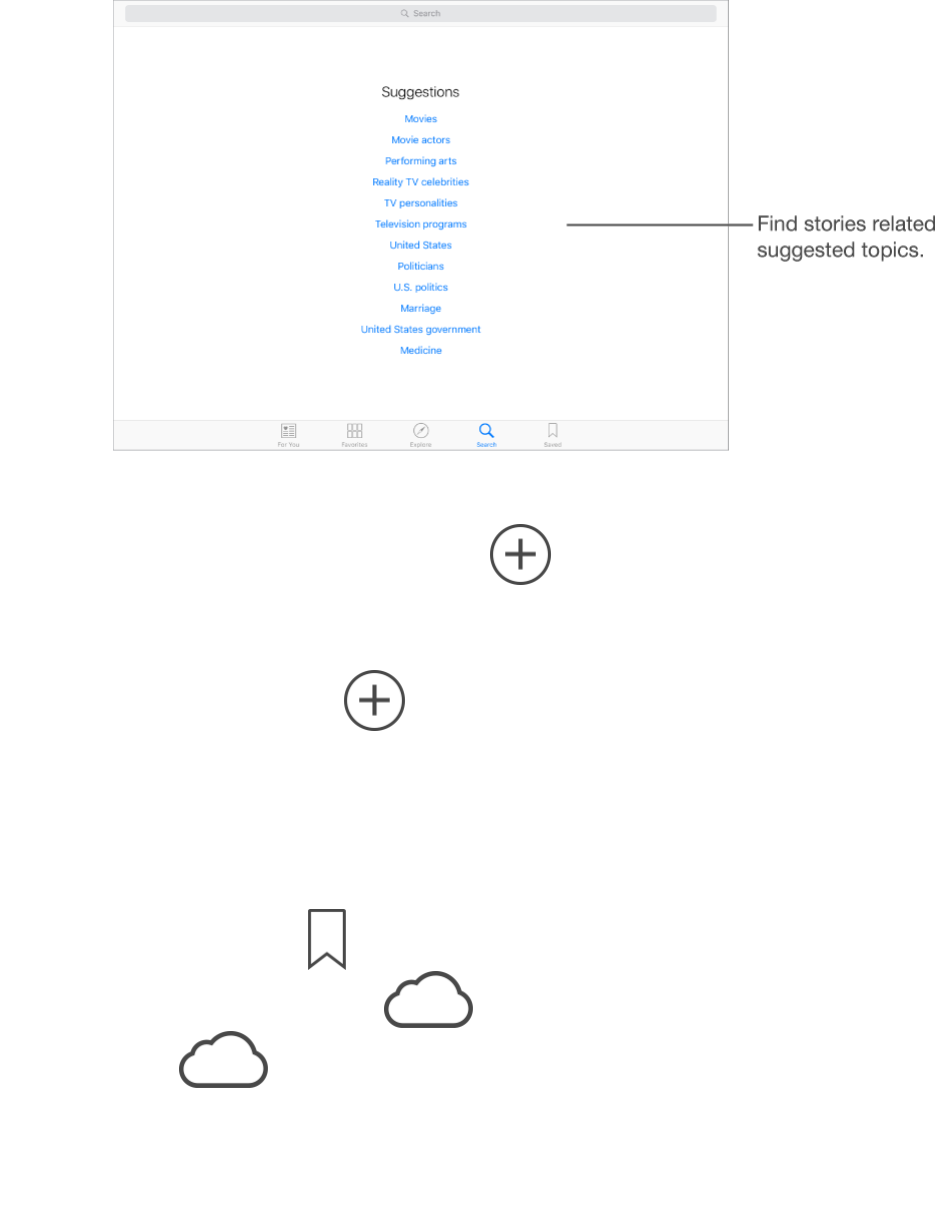
Search for channels and topics.
Tap Search, then enter the name of a channel (CNN or Wired, for example) or a
topic (fashion, business, or politics, for example). Tap to add an item
to your favorites.
View trending topics.
Search offers some suggestions to get you started. Tap a suggestion to see
related topics and channels. Tap to add an item to your favorites.
Save stories
News lets you save stories to read later. You can even read them offline.
Save and delete stories.
When browsing a story, tap to save it. To read a saved story, tap Saved,
then tap the story. Stories that display are not currently saved to
iPad. Tap to save them to iPad for offline reading. Swipe a story
left to delete it.
Check your reading history.
Tap the History tab to see what you’ve read. You can also swipe stories in
History to delete them. To delete your entire history, tap Clear History.
Apple Confidential
162
DRAFT

News settings
Go to Settings > News to set options for News, including:
Refreshing the story list even when you’re not using News
Allowing News to be used over a cellular connection
Displaying stories from RSS feeds as previews or full stories
iTunes Store
iTunes Store at a glance
Use the iTunes Store to add music, movies, TV shows, and more to iPad.
Apple Confidential
163
DRAFT
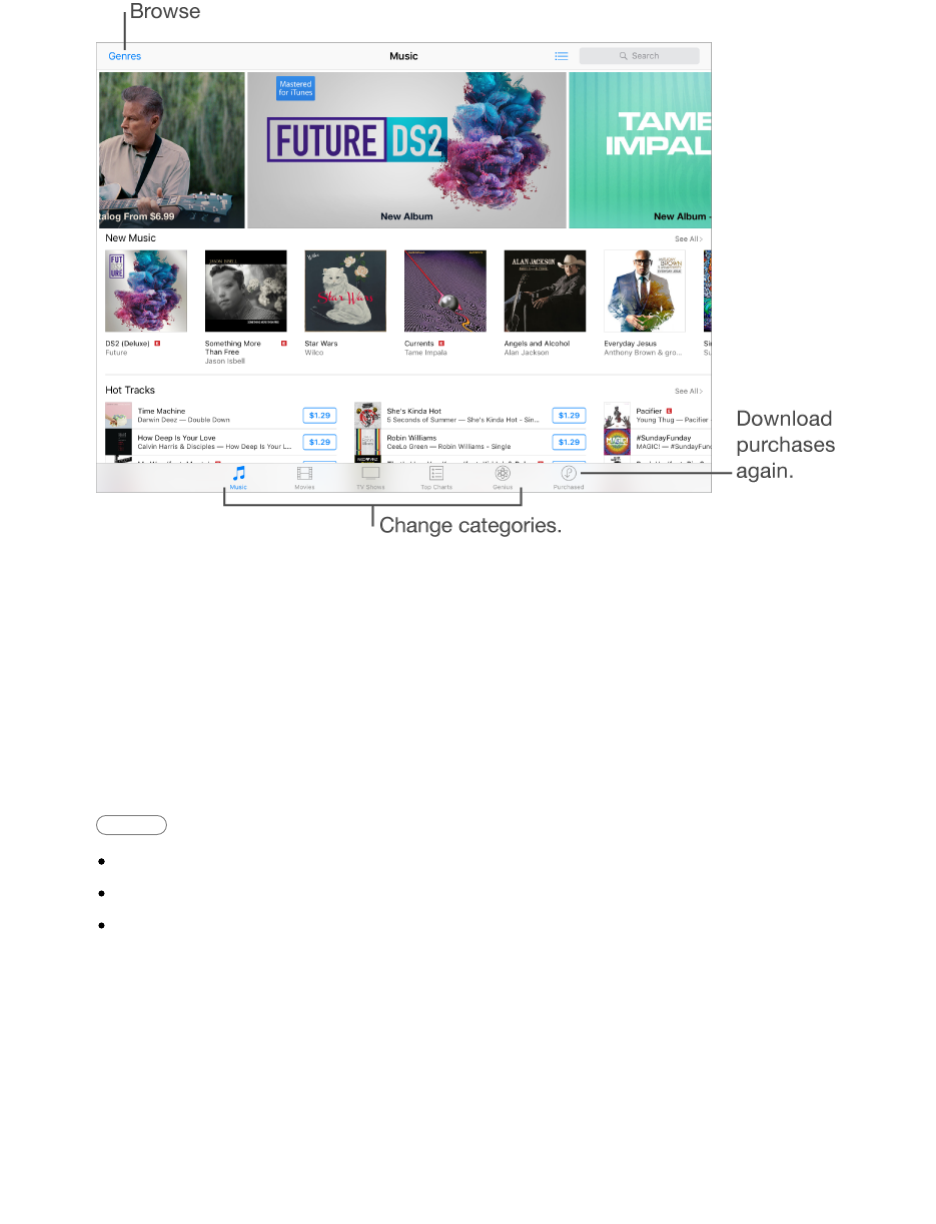
Note: You need an Internet connection and an Apple ID to use the iTunes Store.
The iTunes Store is not available in all areas.
Browse or search
Browse by category or genre.
Tap one of the categories (Music, Movies, TV Shows). Tap Genres to see a list of
genres to choose from.
Ask Siri Say something like:
“Get a new ringtone”
“Purchase song name by band name”
“Redeem an iTunes Store gift card”
If you know what you’re looking for, tap Search.
You can tap a search term that’s trending among other iTunes users, or enter
info in the search field, then tap Search on the keyboard.
Access family members’ purchases.
With Family Sharing turned on, you can view and download songs, TV shows,
and movies purchased by other family members. Tap Purchased, tap your name
or My Purchases, then select a family member from the menu.
Ask Siri to tag it.
When you hear music playing around you, ask Siri “What song is playing?” Siri
tells you what the song is and gives you an easy way to purchase it. It also
Apple Confidential
164
DRAFT

saves it to the Siri tab in the iTunes Store so you can buy it later. Tap Music, tap
, then tap the Siri tab to see a list of tagged songs available for
preview or purchase.
Discover great new music.
When you listen to Radio, songs you play appear in the Radio tab in the
iTunes Store so you can preview or purchase them. Tap Music, tap ,
then tap Radio.
Preview a song or video.
Tap it.
Add to your Wish List.
When you hear something you hope to buy from the iTunes Store, tap ,
then tap Add to Wish List. To view your Wish List in the iTunes Store, tap
, then tap Wish List.
Purchase, rent, or redeem
Tap an item’s price (or tap Free), then tap again to buy it. If you see
instead of a price, you’ve already purchased the item and you can download it
again without a charge.
Approve purchases with Family Sharing.
With Family Sharing set up, the family organizer can review and approve
purchases made by family members under a certain age. For more information,
see Family Sharing (on page) .
Hide individual purchases.
Using iTunes on a computer, family members can hide any of their purchases so
other family members can’t view or download them. For more information, see
Family Sharing (on page) .
Use a gift card or code.
Tap a category (for example, Music), scroll to the bottom, then tap Redeem.
Send a gift.
View the item you want to give, tap , then tap Gift. Or tap one of the
categories (Music, Movies, or TV Shows), scroll to the bottom, then tap Send
Gift to send an iTunes gift certificate to someone.
Bought something on another device?
Go to Settings > iTunes & App Store to set up automatic downloads on your
Apple Confidential
165
DRAFT

iPad. You can always view your purchased music, movies, and TV shows in the
iTunes Store (just tap Purchased).
Watch your time with rentals.
In some areas, you can rent movies. You have 30 days to begin watching a
rented movie. After you start watching it, you can play it as many times as you
want in the allotted time (24 hours in the U.S. iTunes Store; 48 hours in other
countries). Once your time’s up, the movie is deleted. Rentals can’t be
transferred to another device; however, you can use AirPlay and Apple TV to
view a rental on your television.
iTunes Store settings
To set options for the iTunes Store, go to Settings > iTunes & App Store.
View or edit your account.
Tap your Apple ID, then tap View Apple ID. To change your password, tap the
Apple ID field, then tap Password.
Sign in using a different Apple ID.
Tap your account name, then tap Sign Out. You can then enter a different
Apple ID.
Subscribe to or turn on iTunes Match.
You can subscribe to iTunes Match, a service that stores your music and more in
iCloud. See iTunes Match (on page) . If you’re a subscriber, turn on iTunes Match
to access your music on iPad from anywhere.
Turn on automatic downloads.
Tap Music, Books, or Updates. Content updates automatically over Wi-Fi,
unless you turn off the option in Automatic Downloads.
Download purchases over the cellular network.
On iPad Wi-Fi + Cellular models, you can turn on Use Cellular Data.
Downloading purchases, using iTunes Match, or listening to Apple Music over
the cellular network may incur carrier charges.
App Store
Apple Confidential
166
DRAFT
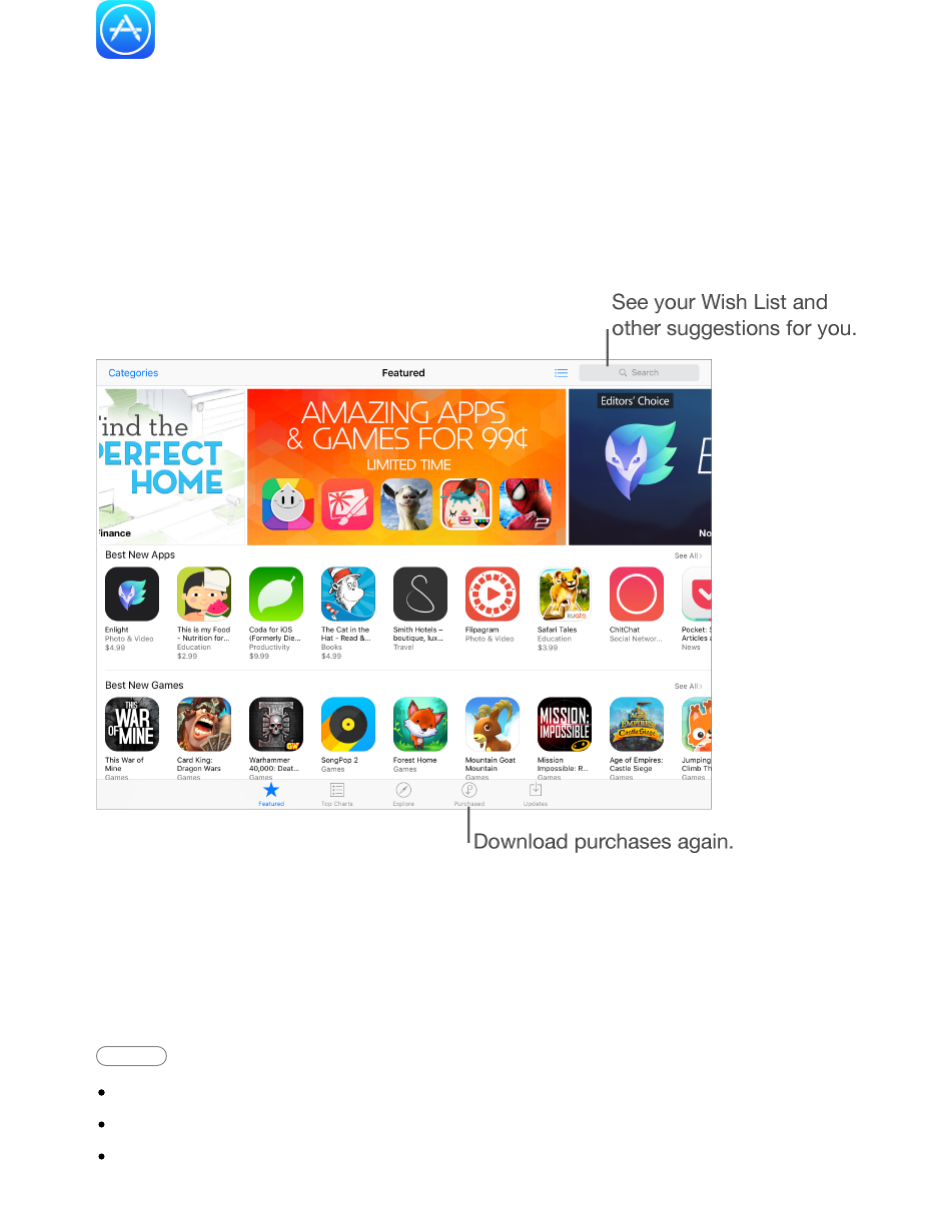
App Store at a glance
Use the App Store to browse, purchase, and download apps specifically
designed for iPad, or for iPhone and iPod touch. Your apps update automatically
over Wi-Fi (unless you turn off this feature), so you can keep up with the latest
improvements and features.
Note: You need an Internet connection and an Apple ID to use the App Store.
The App Store is not available in all areas.
Find apps
Ask Siri Say something like:
“Find apps by Apple”
“Purchase app name”
“Redeem an App Store gift card”
If you know what you’re looking for, tap Search.
Apple Confidential
167
DRAFT

Or tap Categories to browse by type of app.
Access family members’ apps.
With Family Sharing turned on, you can view and download apps purchased by
other family members. Tap Purchased, tap your name or My Purchases, then
select a family member from the menu. For more information, see Family
Sharing (on page) .
Tell a friend about an app.
Find the app, tap , then choose the method. See Share from apps (on
page) .
Use Wish List.
To track an app you might want to purchase later, tap on the app page,
then tap Add to Wish List.
See your Wish List.
After you add items to your Wish List, tap on the Purchased screen.
Search apps by category.
Tap Explore, then tap Categories to focus on the apps you want, for example,
Education, Medical, or Sports.
What apps are being used nearby?
Tap Explore to find out the most popular apps others around you are using
(Location Services must be on in Settings > Privacy > Location Services). Try
this at a museum, sporting event, or when you’re traveling.
Delete an app.
Touch and hold the app icon on the Home screen until the icons jiggle, then tap
. You can’t delete built-in apps. When you finish, press the Home
button. Deleting an app also deletes its data. You can download any app you’ve
purchased from the App Store again, free of charge, subject to their availability.
For information about erasing all of your apps, data, and settings, see Restart or
reset iPad (on page) .
Purchase, redeem, and download
Tap the app’s price, then tap Buy to purchase it. If it’s free, tap Free, then tap
Install.
If you see instead of a price, you’ve already purchased the app and
you can download it again, free of charge. While the app is downloading or
updating, its icon appears on the Home screen with a progress indicator.
Apple Confidential
168
DRAFT

Approve purchases with Family Sharing.
With Family Sharing set up, the family organizer can review and approve
purchases made by other family members, under a certain age. For more
information see Family Sharing (on page) .
Hide individual purchases.
Using iTunes on a computer, family members can hide any of their purchases so
other family members can’t view or download them. For more information, see
Family Sharing (on page) .
Use a gift card or code.
Tap Featured, scroll to the bottom, then tap Redeem.
Send a gift.
View the item you want to give, tap , then tap Gift. Or tap Featured, scroll
to the bottom, then tap Send Gift to send an iTunes gift certificate to someone.
Restrict in-app purchases.
Many apps provide extra content or enhancements for a fee. To limit purchases
that can be made from within an app, go to Settings > General > Restrictions
(make sure Restrictions is enabled), then set options (for example, restrict by
age rating or require a password immediately or every 15 minutes). You can turn
off In-App Purchases to prevent all purchases. See Restrictions (on page) .
Delete an app.
Touch and hold the app icon on the Home screen until the icon jiggles, then tap
. When you finish, press the Home button. You can’t delete built-in
apps. Deleting an app also deletes its data. You can download any app you’ve
purchased from the App Store again, free of charge.
For information about erasing all of your apps, data, and settings, see Reset
iPad settings (on page) .
App Store settings
To set options for App Store, go to Settings > iTunes & App Store.
View or edit your account.
Tap your Apple ID, then tap View Apple ID. To change your password, tap the
Apple ID field, then tap the Password field.
Sign in using a different Apple ID.
Tap your account name, then tap Sign Out. Then enter the other Apple ID.
Turn off automatic downloads.
Tap Apps in Automatic Downloads. Apps update automatically over Wi-Fi,
unless you turn off the option.
Download apps using the cellular network (Wi-Fi + Cellular models).
Turn on Use Cellular Data. Downloading apps over the cellular network may
Apple Confidential
169
DRAFT

incur carrier charges. See Cellular settings (on page) . Newsstand apps update
only over Wi-Fi.
Get app suggestions.
Turn on “Apps on the App Store” to show suggestions relevant to your current
location on the Lock screen and in the app switcher. Turn on Installed Apps to
show suggested apps that are already installed.
iBooks
Get books
Get books from the iBooks Store.
In iBooks, use the buttons at the bottom of the screen to access the iBooks
Store. Tap Featured to browse the latest releases, or Top Charts to view the
most popular. To find a specific book, tap the Search field that appears after you
access the iBooks Store.
Ask Siri Say something like: “Find books by author name.”
Read a book
Apple Confidential
170
DRAFT
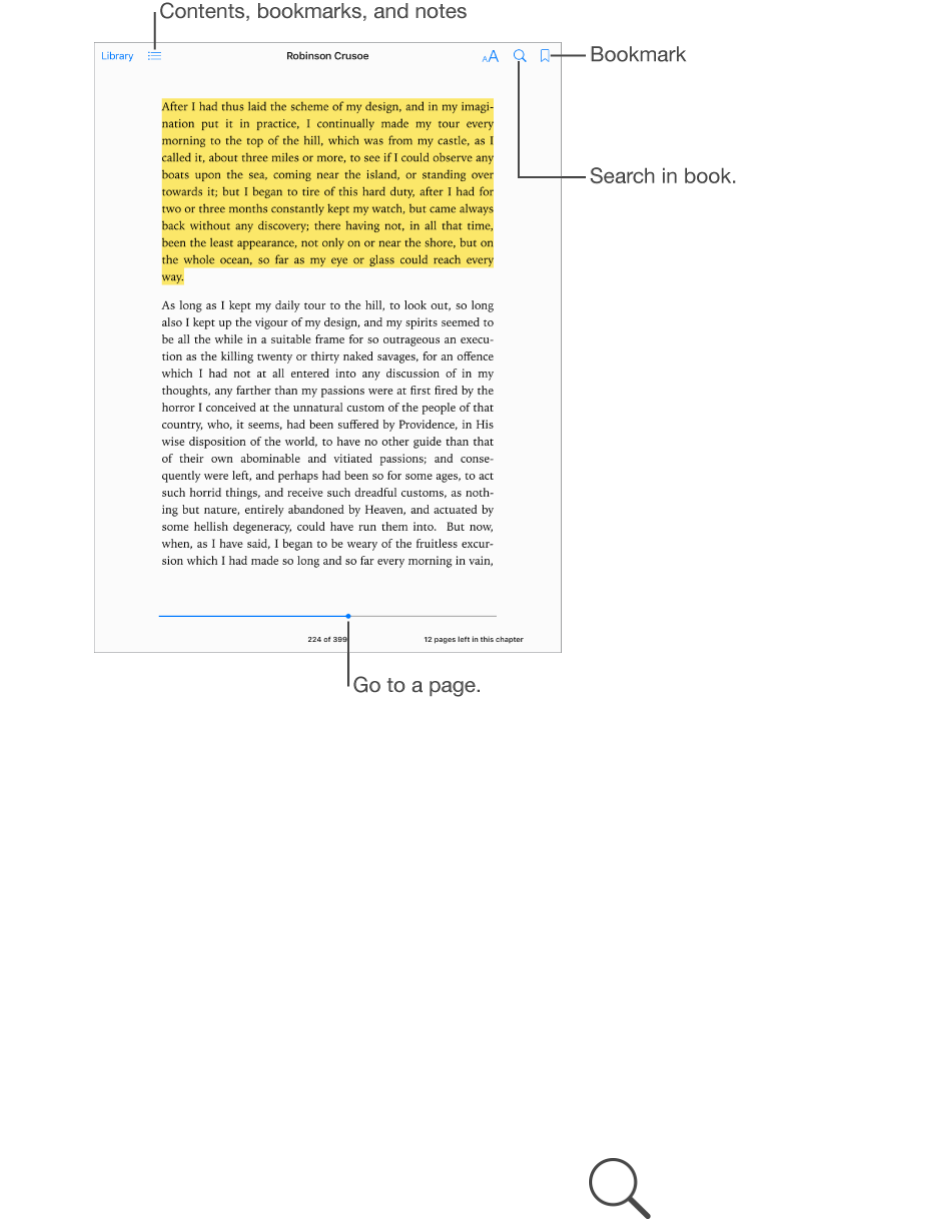
Open a book.
Tap the book you want to read. If you don’t see it in on the bookshelf, swipe left
or right to see other collections.
Show the controls.
Tap near the center of a page. Not all books have the same controls, but some
of the things you can do include searching, viewing the table of contents, and
sharing what you’re reading.
Close a book.
Tap Library, or pinch the page.
Enlarge an image.
Tap, or with some books double-tap, the image.
Read by columns.
In books that support it, double-tap a column of text to zoom in, then swipe up
or to the left to move to the next column.
Go to a specific page.
Use the page navigation controls at the bottom of the screen. Or tap
Apple Confidential
171
DRAFT

and enter a page number, then tap the page number in the search results.
Get a definition.
Double-tap a word, then tap Define in the menu that appears. Definitions aren’t
available for all languages.
Remember your place.
Tap to add a bookmark, or tap again to remove it. You can have multiple
bookmarks—to see them all, tap , then tap Bookmarks. You don’t
need to add a bookmark when you close the book, because iBooks remembers
where you left off.
Remember the good parts.
Some books let you add notes and highlights. To add a highlight, touch and hold
a word, then move your finger to draw the highlight. To add a note, double-tap a
word to select it, move the grab points to adjust the selection, then tap Note or
Highlight in the menu that appears. To see all the notes and highlights you’ve
made, tap , then tap Notes.
Share the good parts.
Tap some highlighted text, then, in the menu that appears, tap . If the
book is from the iBooks Store, a link to the book is included automatically.
(Sharing may not be available in all regions.)
Share a link to a book.
Tap near the center of a page to display the controls, tap , then tap
.
Change the way a book looks.
Some books let you change the font, font size, and color of the page. (Tap
.) You can change justification and hyphenation in Settings > iBooks.
These settings apply to all books that support them.
Apple Confidential
172
DRAFT
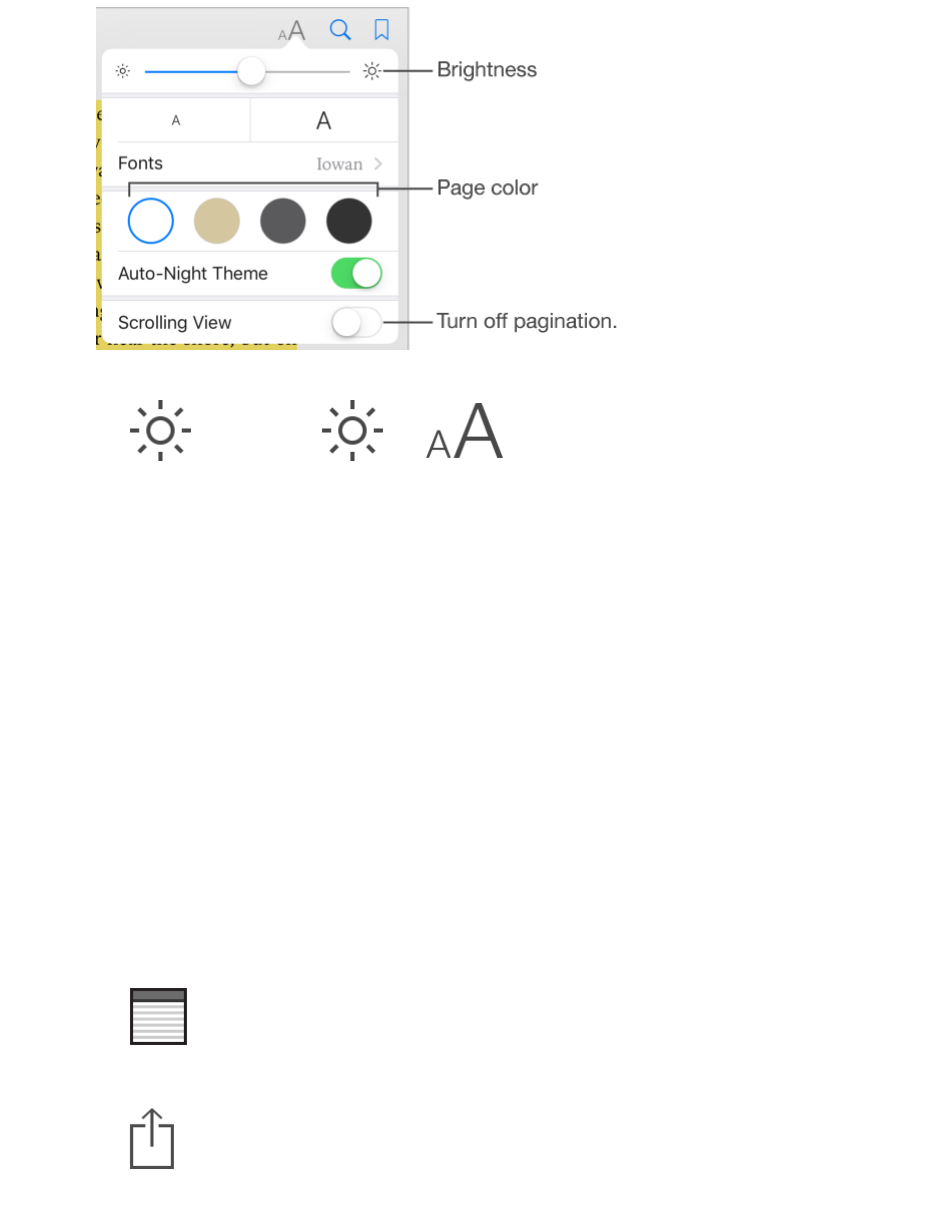
Change the brightness.
Tap . If you don’t see , tap first.
Dim the screen when it’s dark.
Turn on Auto-Night Theme to automatically change the bookshelf, page color,
and brightness when using iBooks in low-light conditions. (Not all books support
Auto-Night Theme.)
Interact with multimedia
Some books have interactive elements, such as movies, diagrams,
presentations, galleries, and 3D objects. To interact with a multimedia object,
tap, swipe, or pinch it. To view an element full screen, pinch open with two
fingers. When you finish, pinch it closed.
Study notes and glossary terms
In books that support it, you can review all of your highlights and notes as study
cards.
See all your notes.
Tap . You can search your notes, or tap a chapter to see notes you
made in that chapter.
Delete notes.
Tap , select some notes, then tap Delete.
Review your notes as study cards.
Apple Confidential
173
DRAFT
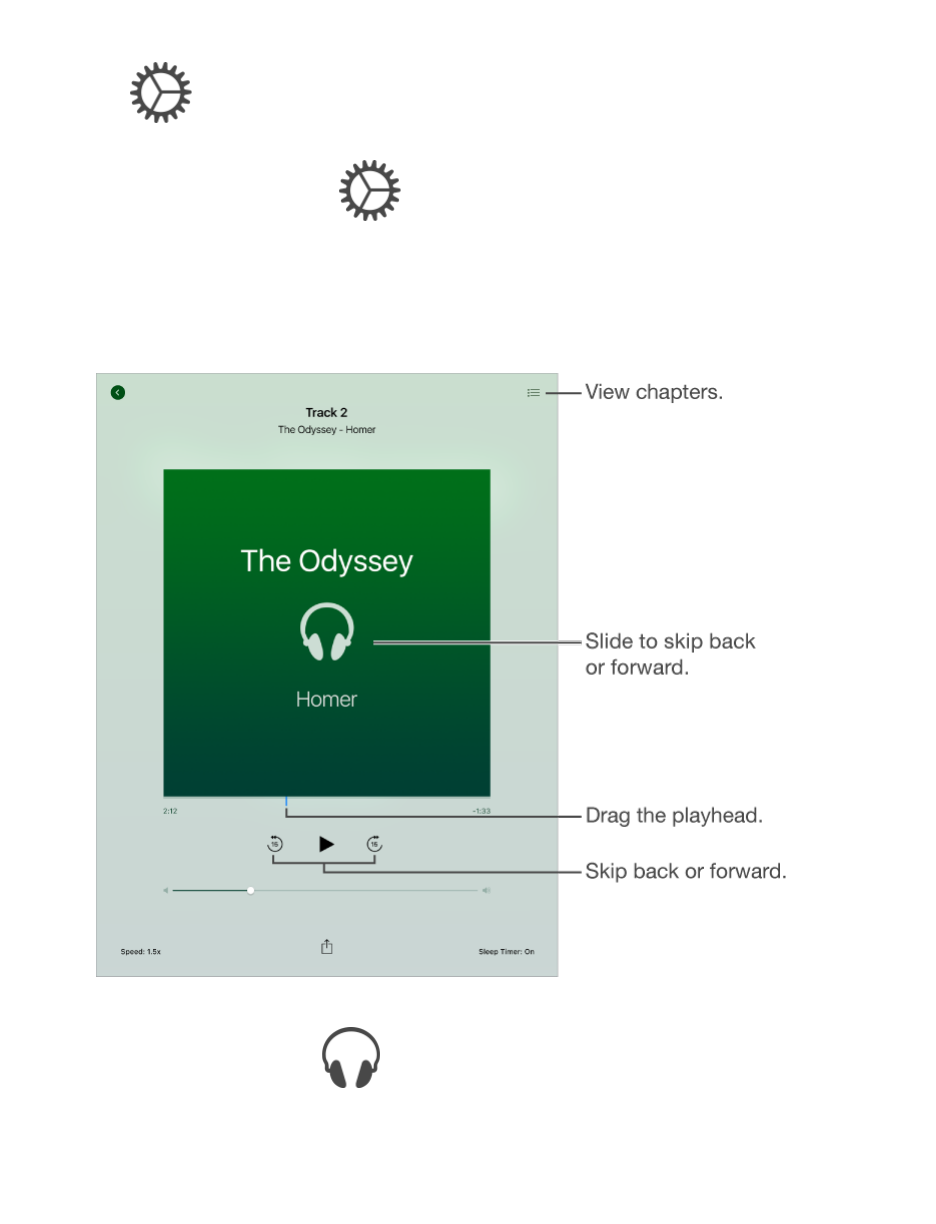
Tap Study Cards. Swipe to move between cards. Tap Flip Card to see its back.
Shuffle your study cards.
Tap , then turn on Shuffle.
Study glossary terms.
If a book includes a glossary, tap to include those words in your study
cards.
Listen to an audiobook
Open an audiobook.
Audiobooks are identified by a on the cover. Tap the book you want to
listen to. If you don’t see it in the library, swipe left or right to view other
collections.
Skip farther forward or back.
Touch and hold the arrows, or slide and hold the cover. To change the number of
seconds that skipping moves, go to Settings > iBooks.
Apple Confidential
174
DRAFT

Speed it up, or slow it down.
Tap Speed, then choose a playback rate. 1x is normal speed, 0.75x is three-
quarters speed, and so on.
Go to a chapter.
Tap , then tap a chapter. Some books don’t define chapter markers
Go to a specific time.
Drag the playhead, located underneath the book cover. Where you started
listening during this session is marked with a small circle on the timeline. Tap the
mark to jump to that spot.
Set a sleep timer.
Before starting playback, tap Sleep Timer, then choose a duration until the audio
automatically stops.
Download a previously purchased audiobook.
You can download a book again from the Purchased list in the iBooks Store
anytime, free of charge.
Organize books
Apple Confidential
175
DRAFT
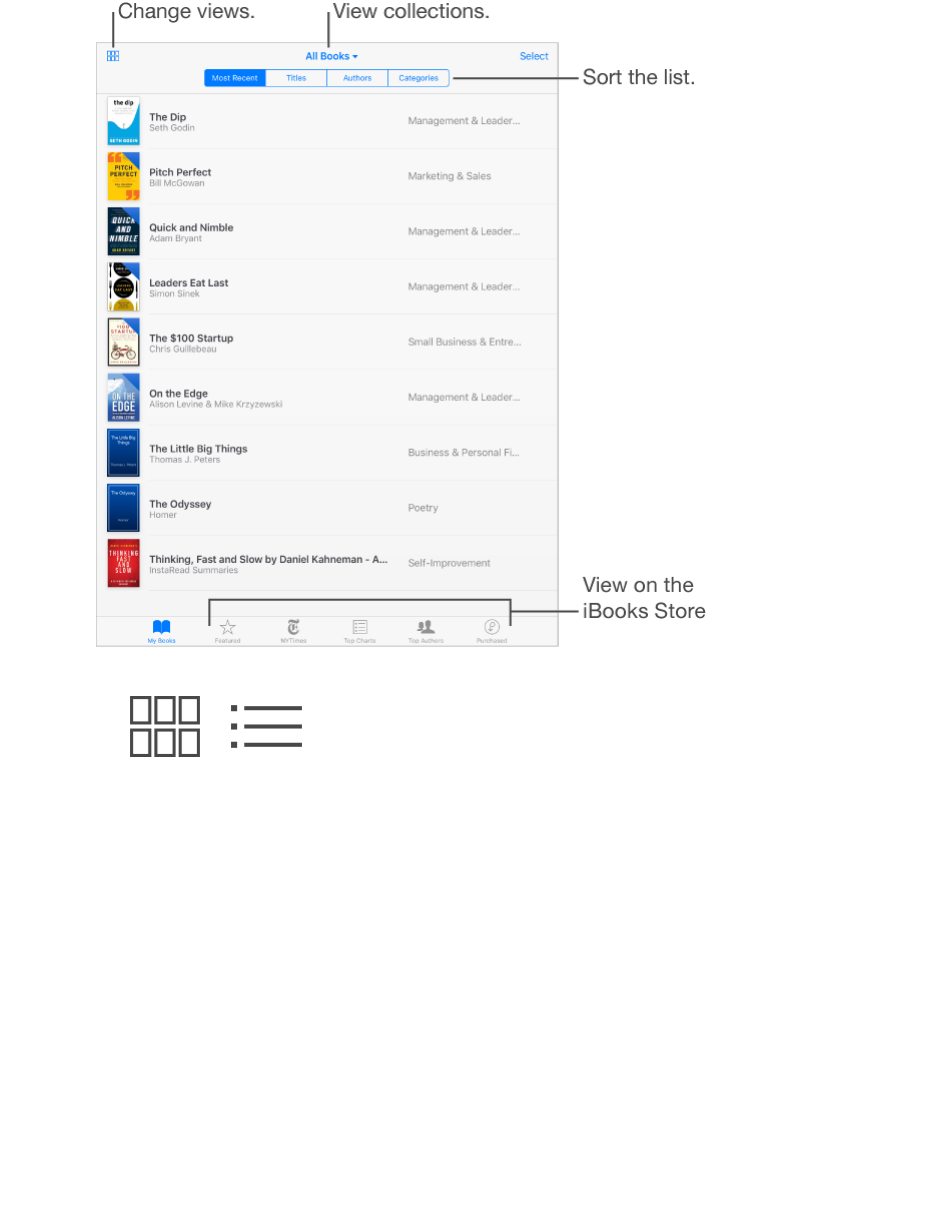
View books by title or cover.
Tap or .
View only audiobooks or PDFs.
Tap the name of the current collection (at the top of the screen) then choose
PDFs or Audiobooks.
Organize your books with collections.
Tap Select, then select some books to add them into a collection. To edit or
create collections, tap the name of the current collection (at the top of the
screen). Some built-in collections, such as PDFs, can’t be renamed or deleted.
Rearrange books.
While viewing books by cover, touch and hold a cover then drag it to a new
location. While viewing books by title, sort the list using the buttons at the top of
the screen. The All Books collection is automatically arranged for you; switch to
another collection if you want to manually arrange your books.
Search for a book.
Pull down to reveal the Search field at the top of the screen. Searching looks for
the title and the author’s name.
Hide purchased books you haven’t downloaded.
Apple Confidential
176
DRAFT

Tap the name of the current collection (at the top of the screen), then turn on
Hide iCloud Books.
Read PDFs
Sync a PDF.
On a Mac, add the PDF to iBooks for OS X, open iTunes, select the PDF, then
sync. In iTunes on your Windows computer, choose File > Add to Library, select
the PDF, then sync. See iTunes Help for more info about syncing.
Add a PDF email attachment to iBooks.
Open the email message, then touch and hold its PDF attachment. Choose
Open in iBooks from the menu that appears.
Print a PDF.
With the PDF open, tap then choose Print. You’ll need an AirPrint-
compatible printer. For more about AirPrint, see AirPrint (on page) .
Email a PDF.
With the PDF open, tap , then choose Email.
iBooks settings
Restrict access to books and audiobooks with explicit content.
Go to Settings > General > Restrictions then select an option for Books.
Go to Settings > iBooks, where you can:
Sync collections and bookmarks (including notes and current page
information) with your other devices.
Display online content within a book. Some books might access video or
audio that’s stored on the web.
Change the direction pages turn when you tap in the left margin.
Podcasts
Apple Confidential
177
DRAFT

Podcasts at a glance
Open Podcasts, then browse, subscribe to, and play your favorite audio or
video podcasts on iPad.
Get podcasts and episodes
Discover more podcasts.
Tap Featured or Top Charts at the bottom of the screen.
Search for new podcasts.
Tap Search at the bottom of the screen.
Search your library.
Tap My Podcasts, then drag down the left of the screen to reveal the Search
field.
Preview or stream an episode.
Tap the podcast, then tap an episode.
Apple Confidential
178
DRAFT
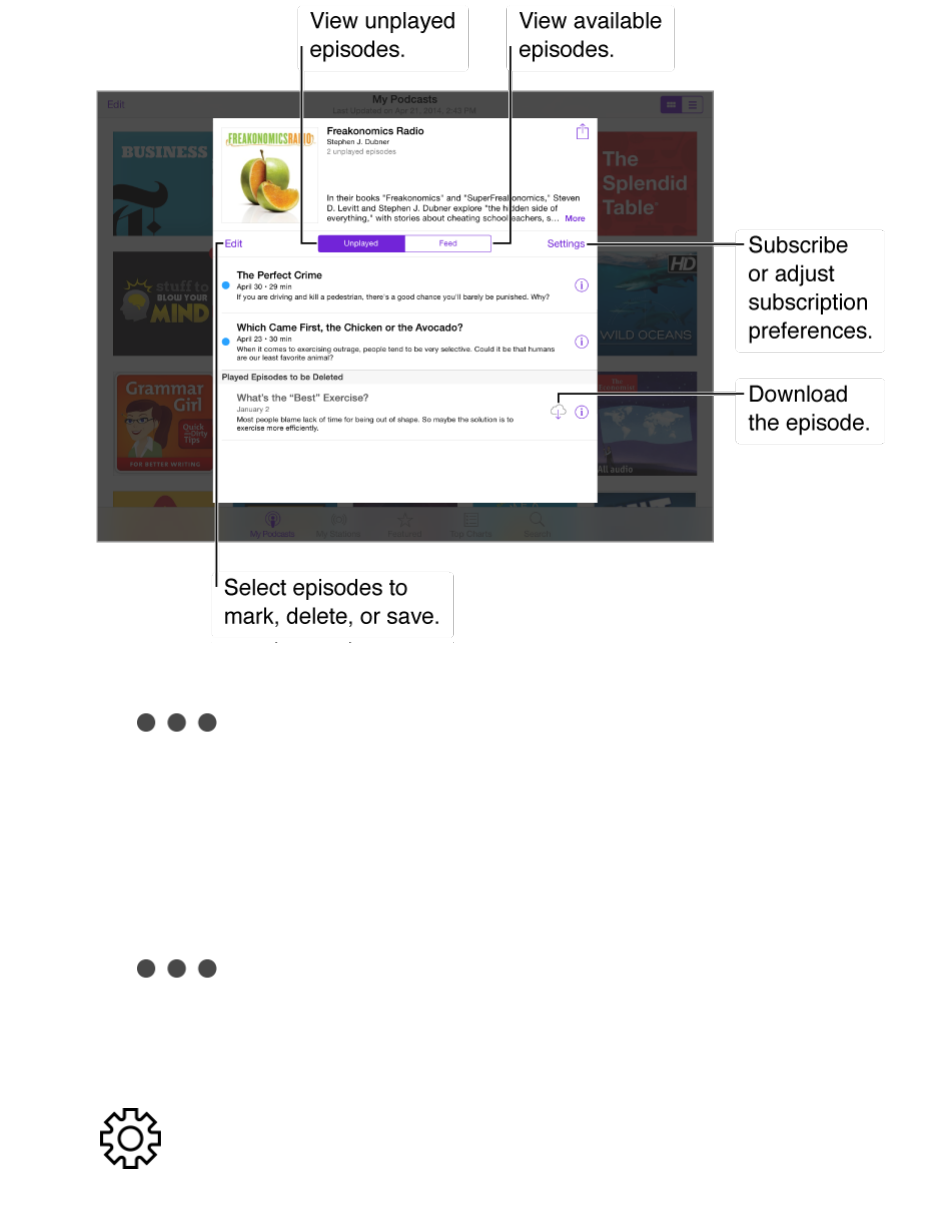
Get more info.
Tap , then tap View Full Description to get episode details. Tap any
links in podcast or episode descriptions to open them in Safari.
Find new episodes.
Tap Unplayed to find episodes you haven’t yet heard.
Browse episodes.
Tap Feed to see episodes available to download or stream.
Download an episode to iPad.
Tap , then tap Download Episode.
Get new episodes as they’re released.
Subscribe to the podcast. If you’re browsing Featured podcasts or Top Charts,
tap the podcast, then tap Subscribe. If you’ve already downloaded episodes,
tap My Podcasts, tap a podcast that appears under Not Subscribed, tap
, then turn on Subscribed.
Save or delete unplayed episodes.
Apple Confidential
179
DRAFT
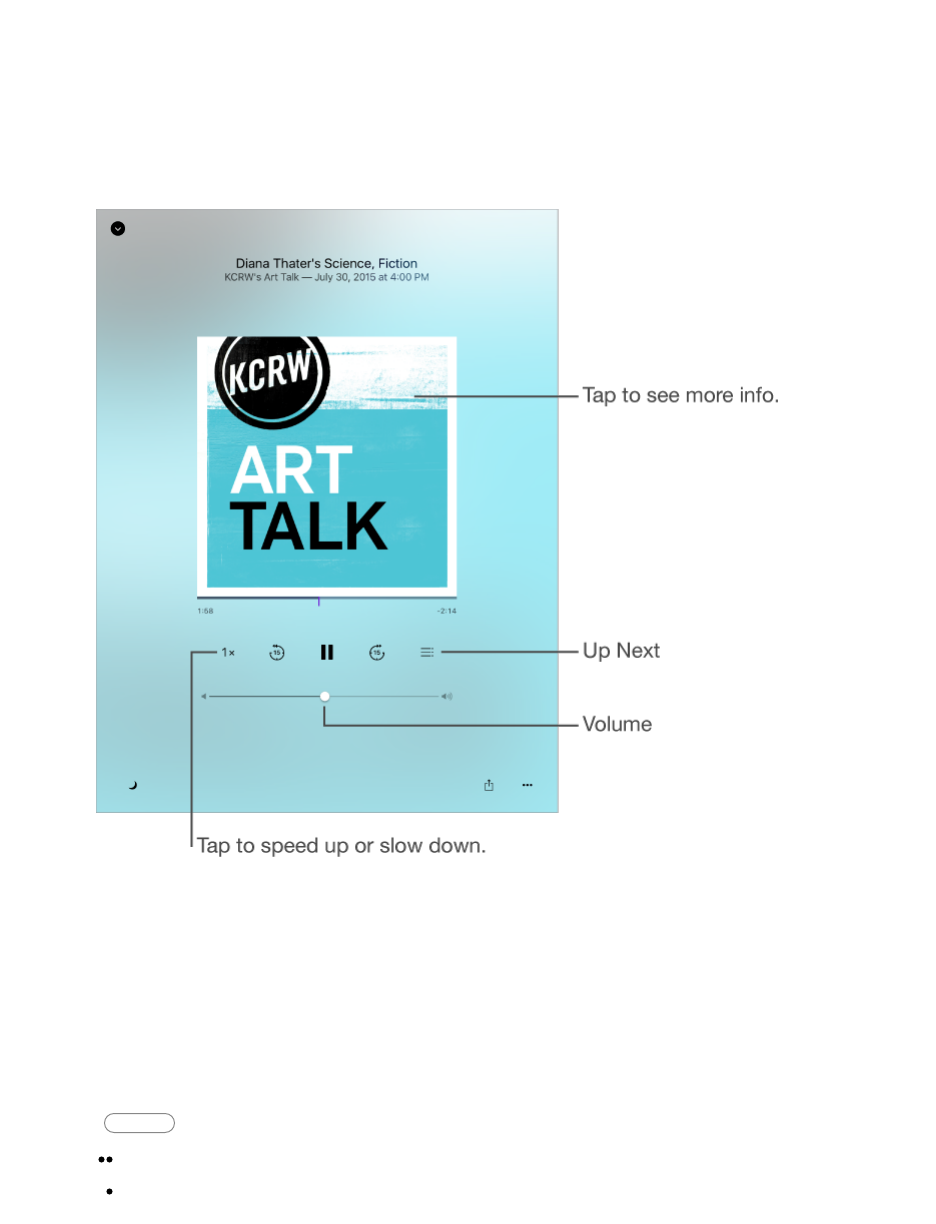
Tap Unplayed, tap Edit, select individual episodes, then tap Save or Delete.
Control playback
Use the playback controls to go forward and back in a podcast, set the speed,
skip episodes, and more.
See podcast info while you listen.
Tap the podcast image on the Now Playing screen.
Skip forward or back with greater accuracy.
Move your finger toward the top of the screen as you drag the playhead left or
right. When you’re close to the playback controls, you can scan quickly through
the entire episode. When you’re close to the top of the screen, you can scan one
second at a time.
Ask Siri Say something like:
“Play podcasts”
“Play it twice as fast”
Apple Confidential
180
DRAFT
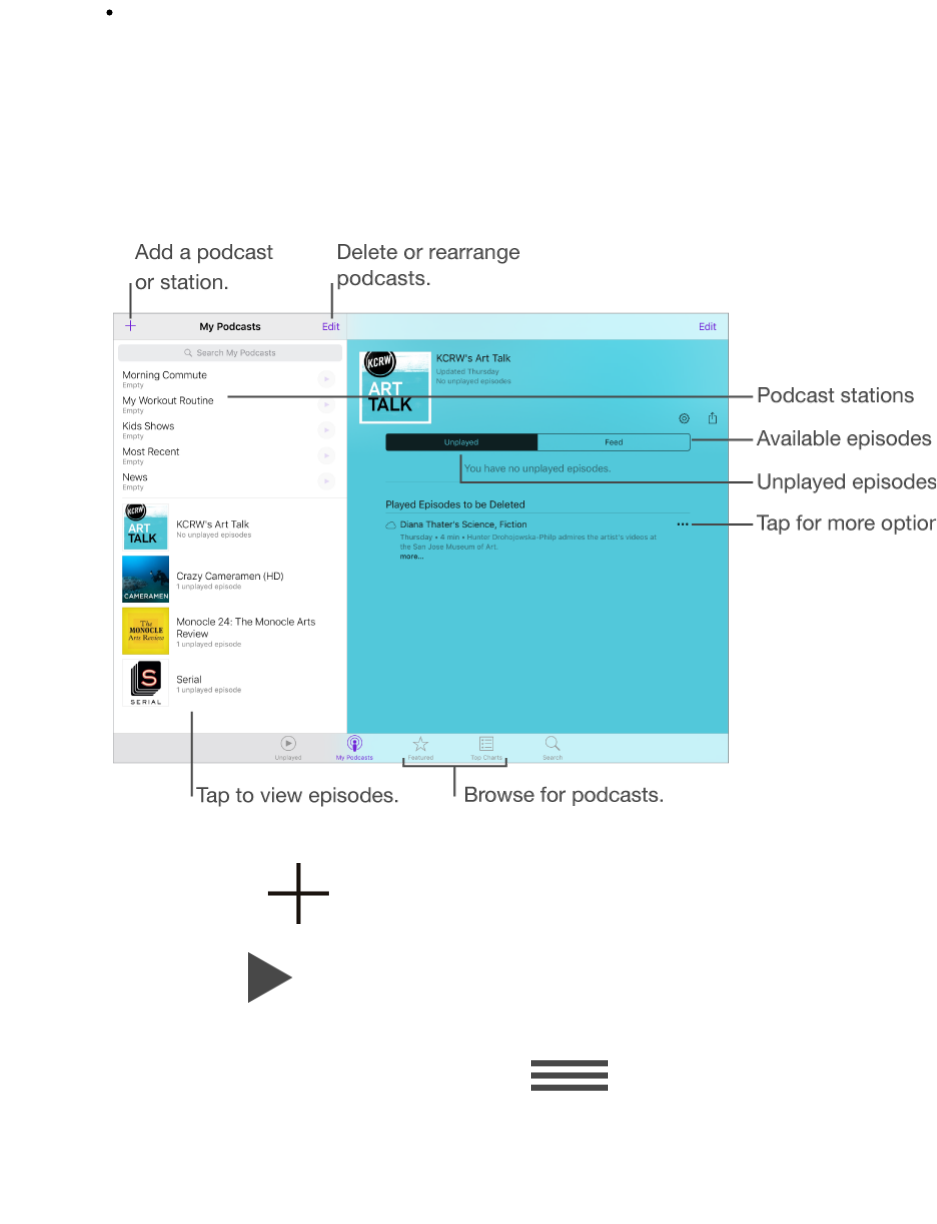
“Play ‘Freakonomics Radio’ podcast”
Organize your favorites into stations
Organize your favorite podcasts into custom stations, and update episodes
automatically across all your devices.
Create a station.
Tap My Podcasts, tap , then tap Add Station. Name your station, tap
Save, then add podcasts. To play the podcasts in your station, tap My
Podcasts, then tap next to the station.
Change the order of the station list.
Tap My Podcasts, tap Edit above the station list, then drag up or
down.
Change the playback order of shows in a station.
Apple Confidential
181
DRAFT

Tap a station, tap Edit at the top-right of the screen, then drag up
or down.
Delete stations.
Tap My Podcasts, tap Edit above the station list, then tap .
List oldest episodes first.
Tap My Podcasts, tap a podcast, tap , then tap Sort Order.
Podcasts settings
Go to Settings > Podcasts, where you can:
Choose to keep your podcast subscriptions up to date on all your devices
Choose how frequently Podcasts checks your subscriptions for new episodes
Have episodes downloaded automatically
Limit the number of podcasts that are downloaded
Choose whether to keep episodes after you finish them
Accessibility
iPad includes a variety of assistive features for people facing challenges,
Apple Confidential
182
DRAFT

including the VoiceOver screen reader and support for braille displays, visual
alerts and mono audio for the deaf or hard of hearing, Guided Access for those
who need help staying on task, and AssistiveTouch and Switch Control for users
with impaired physical or motor skills.
Accessibility features
iPad offers many accessibility features:
Vision
VoiceOver
Support for braille displays
Zoom
Invert Colors and Grayscale
Speak Selection
Speak Screen
Speak Auto-Text
Large, bold, and high-contrast text
Button Shapes
Reduce screen motion
On/off switch labels
Assignable tones
Audio Descriptions
Hearing
Hearing aids
Mono audio and balance
Subtitles and closed captions
Interaction
Siri
Widescreen keyboards
Guided Access
Switch Control
AssistiveTouch
Touch Accommodations
Software and hardware keyboards
Turn on accessibility features.
You can turn on many accessibility features just by asking Siri (“turn on
VoiceOver,” for example). See Siri (on page) and Use Siri. Or go to Settings >
Apple Confidential
183
DRAFT

General > Accessibility, or use the Accessibility Shortcut. See Accessibility
Shortcut.
Use iTunes on your computer to configure accessibility on iPad.
In iTunes you can enable a limited number of accessibility features, including
VoiceOver, zoom, invert colors, speak auto-text, mono audio, and show closed
captions where available. Click Summary, then click Configure Accessibility at
the bottom of the Summary screen.
For more information about iPad accessibility features, go
to www.apple.com/accessibility/.
Accessibility Shortcut
Use the Accessibility Shortcut.
After setting up an accessibility shortcut, press the Home button quickly three
times to engage the associated feature. Features include:
VoiceOver
Invert Colors
Grayscale
Zoom
Switch Control
AssistiveTouch
Guided Access (The shortcut starts Guided Access if it’s already turned on.
See Guided Access.)
Hearing Aid Control (if you have paired Made for iPhone hearing aids)
Choose the features you want to control.
Go to Settings > General > Accessibility > Accessibility Shortcut, then select the
accessibility features you use.
Not so fast.
To slow down the triple-click speed, go to Settings > General > Accessibility >
Home Button. (This also slows down double-clicks.)
VoiceOver
VoiceOver
VoiceOver describes aloud what appears onscreen, so that you can use iPad
without seeing it.
VoiceOver tells you about each item on the screen as you select it. The
VoiceOver cursor (a rectangle) encloses the item and VoiceOver speaks its name
or describes it.
Touch the screen or drag your finger over it to hear the items on the screen.
Apple Confidential
184
DRAFT

When you select text, VoiceOver reads the text. If you turn on Speak Hints,
VoiceOver may tell you the name of the item and provide instructions—for
example, “double-tap to open.” To interact with items on the screen, such as
buttons and links, use the gestures described in Learn VoiceOver gestures.
When you go to a new screen, VoiceOver plays a sound, then selects and
speaks the first item on the screen (typically in the upper-left corner). VoiceOver
also lets you know when the display changes to landscape or portrait
orientation, and when the screen becomes dimmed or locked.
Note: VoiceOver speaks in the language specified in Settings > General >
Language & Region. VoiceOver is available in many languages, but not all.
Use iPad with VoiceOver
Unlock iPad.
Press either the Sleep/Wake or Home button, drag the slider, then double-tap
the screen. On iPad models with Touch ID, you can unlock iPad by placing your
finger on the Home button. See Touch ID.
Enter your passcode silently.
To avoid having your passcode spoken as you enter it, use handwriting; see
Write with your finger.
Open an app, toggle a switch, or tap an item.
Select the item, then double-tap the screen.
Double-tap the selected item.
To invoke a command normally executed by tapping twice on the screen—
selecting a word or zooming an image, for example—tap three times.
Adjust a slider.
Select the slider, then swipe up or down with one finger.
Use a standard gesture.
Double-tap and hold your finger on the screen until you hear three rising tones,
then make the gesture. When you lift your finger, VoiceOver gestures resume.
For example, to drag a volume slider with your finger instead of swiping up and
down, select the slider, double-tap and hold, wait for the three tones, then slide
left or right.
Scroll a list or area of the screen.
Swipe up or down with three fingers.
Scroll continuously through a list: Double-tap and hold until you hear three
rising tones, then drag up or down.
Use the list index: Some lists have an alphabetical table index along the right
side. Select the index, then swipe up or down to move through the index. You
can also double-tap, hold, then slide your finger up or down.
Reorder a list: You can change the order of items in some lists, such as the
Rotor items in Accessibility settings. Select to the right of an
item, double-tap and hold until you hear three rising tones, then drag up or
down.
Apple Confidential
185
DRAFT

Open Notification Center.
Select any item in the status bar, then swipe down with three fingers. To dismiss
Notification Center, do a two-finger scrub (move two fingers back and forth three
times quickly, making a “z”).
Open Control Center.
Select any item in the status bar, then swipe up with three fingers. To dismiss
Control Center, do a two-finger scrub.
Switch apps.
Double-click the Home button to display open apps, swipe left or right with one
finger to select an app, then double-tap to switch to it. Or, set the rotor to
Actions while viewing open apps, then swipe up or down.
Rearrange your Home screen.
Select an icon on the Home screen, double-tap and hold, then drag. Lift your
finger when the icon is in its new location. Drag an icon to the edge of the
screen to move it to another Home screen. You can continue to select and move
items until you press the Home button.
Speak iPad status information.
Tap the status bar at the top of the screen, then swipe left or right to hear
information about the time, battery state, Wi-Fi signal strength, and more.
Speak notifications.
Go to Settings > General > Accessibility > VoiceOver, then turn on Always Speak
Notifications. Notifications, including the text of incoming text messages, are
spoken as they occur, even if iPad is locked. Unacknowledged notifications are
repeated when you unlock iPad.
Turn the screen curtain on or off.
Triple-tap with three fingers. When the screen curtain is on, the screen contents
are active even though the display is turned off.
VoiceOver basics
Important: VoiceOver changes the gestures you use to control iPad. When
VoiceOver is on, you must use VoiceOver gestures—even to turn VoiceOver off.
Turn VoiceOver on or off.
Press and hold the Home button and tell Siri “turn VoiceOver on.” To turn
VoiceOver off, tell Siri “turn VoiceOver off.” You can also go to Settings >
General > Accessibility > VoiceOver, or use the Accessibility Shortcut. See
Accessibility Shortcut.
Explore.
Drag your finger over the screen. VoiceOver speaks each item you touch. Lift
your finger to leave an item selected.
Select an item: Tap once to select an item, double-tap to invoke it.
Select the next or previous item: Swipe right or left with one finger. Item order
is left-to-right, top-to-bottom.
Select the item above or below: Set the rotor to Vertical Navigation, then
swipe up or down with one finger. If you don’t find Vertical Navigation in the
Apple Confidential
186
DRAFT

rotor, you can add it; see Use the VoiceOver rotor.
Select the first or last item on the screen: Tap with four fingers at the top or
bottom of the screen.
Select an item by name: Triple-tap with two fingers anywhere on the screen to
open the Item Chooser. Then type a name in the search field, or swipe right or
left to move through the list alphabetically, or tap the table index to the right
of the list and swipe up or down to move quickly through the list of items. You
can also use handwriting to select an item by writing its name; see Write with
your finger. To dismiss the Item Chooser without making a selection, double-
tap.
Change an item’s name so it’s easier to find: Select the item, then double-tap
and hold with two fingers anywhere on the screen.
Speak the text of the selected item: Set the rotor to characters or words, then
swipe down or up with one finger.
Turn spoken hints on or off: Go to Settings > General > Accessibility >
VoiceOver > Speak Hints.
Use phonetic spelling: Go to Settings > General > Accessibility > VoiceOver >
Phonetic Feedback.
Speak the entire screen, from the top: Swipe up with two fingers.
Speak from the current item to the bottom of the screen: Swipe down with
two fingers.
Pause speaking: Tap once with two fingers. Tap again with two fingers to
resume, or select another item.
Mute VoiceOver: Double-tap with three fingers; repeat to unmute. If you’re
using an external keyboard, press the Control key.
Silence sound effects: Go to Settings > General > Accessibility > VoiceOver,
then turn off Use Sound Effects.
Use a larger VoiceOver cursor.
Go to Settings > General > Accessibility > VoiceOver, then turn on Large Cursor.
Adjust the speaking voice.
You can adjust the VoiceOver speaking voice:
Change the volume: Use the volume buttons on iPad. You can also add
volume to the rotor, then swipe up and down to adjust; see Use the
VoiceOver rotor.
Change the speech rate: Go to Settings > General > Accessibility >
VoiceOver, then drag the Speaking Rate slider. You can also set the rotor to
Speech Rate, then swipe up or down to adjust.
Use pitch change: VoiceOver uses a higher pitch when speaking the first item
of a group (such as a list or table) and a lower pitch when speaking the last
item of a group. Go to Settings > General > Accessibility > VoiceOver > Use
Pitch Change.
Speak punctuation: Set the rotor to Punctuation, then swipe up or down to to
select how much you want to hear.
Control audio ducking: To choose whether audio that’s playing is turned down
Apple Confidential
187
DRAFT

while VoiceOver speaks, set the rotor to Audio Ducking, then swipe up or
down.
Change the language for iPad: Go to Settings > General > Language &
Region. VoiceOver pronunciation of some languages is affected by the
Region Format you choose there.
Change pronunciation: Set the rotor to Language, then swipe up or down.
Language is available in the rotor only if you add a language at Settings >
General > Accessibility > VoiceOver > Speech > Rotor Languages.
Choose which dialects are available in the rotor: Go to Settings > General >
Accessibility > VoiceOver > Speech > Rotor Languages. To adjust voice
quality or speaking rate, tap next to the language. To remove
languages from the rotor or change their order, tap Edit, tap the delete button
or drag up or down, then tap Done.
Set the default dialect for the current iPad language: Go to Settings >
General > Accessibility > VoiceOver > Speech.
Download an enhanced quality reading voice: Go to Settings > General >
Accessibility > VoiceOver > Speech, tap a language, then choose an
enhanced voice. By default, VoiceOver uses the Siri voice. If you’re using
English, you can choose to download Alex (869 MB), the same high-quality
U.S. English voice used for VoiceOver on Mac computers.
Learn VoiceOver gestures
When VoiceOver is on, standard touchscreen gestures have different effects,
and additional gestures let you move around the screen and control individual
items. VoiceOver gestures include two-, three-, and four-finger taps and swipes.
For best results using multi-finger gestures, relax and let your fingers touch the
screen with some space between them.
You can use different techniques to enter a particular VoiceOver gesture. For
example, you can perform a two-finger tap using two fingers on one hand, or
one finger on each hand. You can even use your thumbs. Some people use a
split-tap gesture: instead of selecting an item and double-tapping, touch and
hold an item with one finger, then tap the screen with another finger.
Try different techniques to discover which works best for you. If a gesture
doesn’t work, try a quicker movement, especially for a double-tap or swipe
gesture. To swipe, try brushing the screen quickly with your finger or fingers.
In VoiceOver settings, you can enter a special area where you can practice
VoiceOver gestures without affecting iPad or its settings.
Practice VoiceOver gestures.
Go to Settings > General > Accessibility > VoiceOver, then tap VoiceOver
Practice. When you finish practicing, tap Done. If you don’t see the VoiceOver
Practice button, make sure VoiceOver is turned on.
Here are some key VoiceOver gestures:
Navigate and read
Apple Confidential
188
DRAFT

Tap: Select and speak the item.
Swipe right or left: Select the next or previous item.
Swipe up or down: Depends on the rotor setting. See Use the VoiceOver
rotor.
Two-finger swipe up: Read all from the top of the screen.
Two-finger swipe down: Read all from the current position.
Two-finger tap: Stop or resume speaking.
Two-finger scrub: Move two fingers back and forth three times quickly
(making a “z”) to dismiss an alert or go back to the previous screen.
Three-finger swipe up or down: Scroll one page at a time.
Three-finger swipe right or left: Go to the next or previous page (on the Home
screen, for example).
Three-finger tap: Speak additional information, such as position within a list
or whether text is selected.
Four-finger tap at top of screen: Select the first item on the page.
Four-finger tap at bottom of screen: Select the last item on the page.
Activate
Double-tap: Activate the selected item.
Triple-tap: Double-tap an item.
Split-tap: As an alternative to selecting an item and double-tapping to
activate it, touch and hold an item with one finger, then tap the screen with
another.
Double-tap and hold (1 second) + standard gesture: Use a standard gesture.
The double-tap and hold gesture tells iPad to interpret the next gesture as
standard. For example, you can double-tap and hold, then without lifting your
finger, drag your finger to slide a switch.
Two-finger double-tap: Play or pause in Music, Videos, or Photos. Take a
photo or start or pause recording in Camera. Start or stop the stopwatch.
Two-finger double-tap and hold: Change an item’s label to make it easier to
find.
Two-finger triple-tap: Open the Item Chooser.
Three-finger double-tap: Mute or unmute VoiceOver.
Three-finger triple-tap: Turn the screen curtain on or off.
Use the VoiceOver rotor
Use the rotor to choose what happens when you swipe up or down with
VoiceOver turned on, or to select special input methods such as Braille Screen
Input or Handwriting.
Operate the rotor.
Rotate two fingers on the screen around a point between them.
Apple Confidential
189
DRAFT

Choose your rotor options.
Go to Settings > General > Accessibility > VoiceOver > Rotor, then select the
options you want to include in the rotor.
The available rotor options and their effects depend on what you’re doing. For
example, if you’re reading an email, you can use the rotor to switch between
hearing text spoken word-by-word or character-by-character when you swipe
up or down. If you’re browsing a webpage, you can set the rotor to speak all the
text (either word-by-word or character-by-character), or to jump from one item
to another of a certain type, such as headers or links.
When you use an Apple Wireless Keyboard to control VoiceOver, the rotor lets
you adjust settings such as volume, speech rate, use of pitch or phonetics,
typing echo, and reading of punctuation. See Use VoiceOver with an Apple
Wireless Keyboard.
Use the onscreen keyboard
When you activate an editable text field, the onscreen keyboard appears (unless
you have an Apple Wireless Keyboard attached).
Activate a text field.
Select the text field, then double-tap. The insertion point and the onscreen
keyboard appear.
Enter text.
Type characters using the onscreen keyboard:
Standard typing: Select a key on the keyboard by swiping left or right, then
double-tap to enter the character. Or move your finger around the keyboard
to select a key and, while continuing to touch the key with one finger, tap the
screen with another finger. VoiceOver speaks the key when it’s selected, and
again when the character is entered.
Touch typing: Touch a key on the keyboard to select it, then lift your finger to
enter the character. If you touch the wrong key, slide your finger to the key
you want. VoiceOver speaks the character for each key as you touch it, but
doesn’t enter a character until you lift your finger.
Direct Touch typing: VoiceOver is disabled for the keyboard only, so you can
type just as you do when VoiceOver is off.
Choose typing style: Go to Settings > General > Accessibility > VoiceOver >
Typing Style. Or, set the rotor to Typing Mode, then swipe up or down.
Move the insertion point.
Swipe up or down to move the insertion point forward or backward in the text.
Use the rotor to choose whether you want to move the insertion point by
Apple Confidential
190
DRAFT

character, by word, or by line. To jump to the beginning or end, double-tap the
text.
VoiceOver makes a sound when the insertion point moves, and speaks the
character, word, or line that the insertion point moves across. When moving
forward by words, the insertion point is placed at the end of each word, before
the space or punctuation that follows. When moving backward, the insertion
point is placed at the end of the preceding word, before the space or
punctuation that follows it.
Move the insertion point past the punctuation at the end of a word or
sentence.
Use the rotor to switch back to character mode.
When moving the insertion point by line, VoiceOver speaks each line as you
move across it. When moving forward, the insertion point is placed at the
beginning of the next line (except when you reach the last line of a paragraph,
when the insertion point is moved to the end of the line just spoken). When
moving backward, the insertion point is placed at the beginning of the line that’s
spoken.
Change typing feedback.
Go to Settings > General > Accessibility > VoiceOver > Typing Feedback.
Use phonetics in typing feedback.
Go to Settings > General > Accessibility > VoiceOver > Phonetic Feedback. Text
is read character by character. VoiceOver first speaks the character, then its
phonetic equivalent—for example, “f” and then “foxtrot.”
Delete a character.
Use with any of the VoiceOver typing styles. VoiceOver speaks
each character as it’s deleted. If Use Pitch Change is turned on, VoiceOver
speaks deleted characters in a lower pitch.
Select text.
Set the rotor to Edit, swipe up or down to choose Select or Select All, then
double-tap. If you choose Select, the word closest to the insertion point is
selected when you double-tap. To increase or decrease the selection, do a two-
finger scrub to dismiss the pop-up menu, then pinch.
Cut, copy, or paste.
Set the rotor to Edit, select the text, swipe up or down to choose Cut, Copy, or
Paste, then double-tap.
Undo.
Shake iPad, swipe left or right to choose the action to undo, then double-tap.
Enter an accented character.
In standard typing style, select the plain character, then double-tap and hold
until you hear a sound indicating alternate characters have appeared. Drag left
or right to select and hear the choices. Release your finger to enter the current
selection. In touch typing style, touch and hold a character until the alternate
characters appear.
Apple Confidential
191
DRAFT

Change the keyboard language.
Set the rotor to Language, then swipe up or down. Choose “default language” to
use the language specified in Language & Region settings. The Language rotor
item appears only if you select more than one language in Settings > General >
Accessibility > VoiceOver > Speech.
Write with your finger
Handwriting mode lets you enter text by writing characters on the screen with
your finger. In addition to normal text entry, use handwriting mode to enter your
iPad passcode silently or open apps from the Home screen.
Enter handwriting mode.
Use the rotor to select Handwriting. If Handwriting isn’t in the rotor, go to
Settings > General > Accessibility > VoiceOver > Rotor, then add it.
Choose a character type.
Swipe up or down with three fingers to choose lowercase, numbers, uppercase,
or punctuation.
Hear the currently selected character type.
Tap with three fingers.
Enter a character.
Trace the character on the screen with your finger.
Enter a space.
Swipe right with two fingers.
Go to a new line.
Swipe right with three fingers.
Delete the character before the insertion point.
Swipe left with two fingers.
Select an item on the Home screen.
Start writing the name of the item. If there are multiple matches, continue to
spell the name until it’s unique, or swipe up or down with two fingers to choose
from the current matches.
Enter your passcode silently.
Set the rotor to Handwriting on the passcode screen, then write the characters
of your passcode.
Use a table index to skip through a long list.
Select the table index to the right of the table (for example, next to your
Contacts list or in the VoiceOver Item Chooser), then write the letter.
Set the rotor to a web browsing element type.
Write the first letter of a page element type. For example, write “l” to have up or
down swipes skip to links, or “h” to skip to headings.
Exit handwriting mode.
Do a two-finger scrub, or turn the rotor to a different selection.
Type onscreen braille
Apple Confidential
192
DRAFT

With Braille Screen Input enabled, you can use your fingers to enter 6-dot, 8-
dot, or contracted braille codes directly on the iPad screen. Tap codes with iPad
laying flat in front of you (tabletop mode), or hold iPad with the screen facing
away so your fingers curl back to tap the screen (screen away mode).
Turn on Braille Screen Input.
Use the rotor to select Braille Screen Input. If you don’t find it in the rotor, go to
Settings > General > Accessibility > VoiceOver > Rotor, then add it.
Enter braille codes.
Place iPad flat in front of you or hold it with the screen facing away, then tap the
screen with one or several fingers at the same time.
Adjust entry dot positions.
To move the entry dots to match your natural finger positions, double-tap six or
eight fingers at the same time.
Switch between 6-dot, 8-dot, and contracted braille.
Swipe to the right with three fingers. To set the default, go to Settings >
General > Accessibility > VoiceOver > Braille > Braille Screen Input.
Enter a space.
Swipe right with one finger. (In screen away mode, swipe to your right.)
Delete the previous character.
Swipe left with one finger.
Move to a new line (typing).
Swipe right with two fingers.
Cycle through spelling suggestions.
Swipe up or down with one finger.
Select an item on the Home screen.
Start entering the name of the item. If there are multiple matches, continue to
spell the name until it is unique, or swipe up or down with one finger to select a
partial match.
Open the selected app.
Swipe right with two fingers.
Turn braille contractions on or off.
Swipe to the right with three fingers.
Translate immediately (when contractions are enabled).
Swipe down with two fingers.
Stop entering braille.
Do a two-finger scrub, or set the rotor to another setting.
Use VoiceOver with an Apple Wireless Keyboard
You can control VoiceOver using an Apple Wireless Keyboard paired with iPad.
See Bluetooth devices.
Use VoiceOver keyboard commands to navigate the screen, select items, read
screen contents, adjust the rotor, and perform other VoiceOver actions. For the
Apple Confidential
193
DRAFT

commands, you can use the Control-Option key combination or the Caps Lock
key, abbreviated in the list that follows as “VO.” (To choose a modifier key, go
to Settings > General > Accessibility > VoiceOver > Modifier Keys.)
You can use VoiceOver Help to learn the keyboard layout and the actions
associated with various key combinations. VoiceOver Help speaks keys and
keyboard commands as you type them, without performing the associated
action.
VoiceOver keyboard commands
VO = Control-Option
Turn on VoiceOver Help: VO–K
Turn off VoiceOver Help: Escape
Select the next or previous item: VO–Right Arrow or VO–Left Arrow
Double-tap to activate the selected item: VO–Space bar
Press the Home button: VO–H
Touch and hold the selected item: VO–Shift–M
Move to the status bar: VO–M
Read from the current position: VO–A
Read from the top: VO–B
Pause or resume reading: Control
Copy the last spoken text to the clipboard: VO–Shift–C
Search for text: VO–F
Mute or unmute VoiceOver: VO–S
Open Notification Center: Fn–VO–Up Arrow
Open Control Center: Fn–VO–Down Arrow
Open the Item Chooser: VO–I
Change the label of the selected item: VO–/
Double-tap with two fingers: VO–”-”
Adjust the rotor: Use Quick Nav (see below)
Swipe up or down: VO–Up Arrow or VO–Down Arrow
Adjust the speech rotor: VO–Command–Left Arrow or VO–Command–Right
Arrow
Adjust the setting specified by the speech rotor: VO–Command–Up Arrow or
VO–Command–Down Arrow
Turn the screen curtain on or off: VO–Shift–S
Return to the previous screen: Escape
Switch apps: Command–Tab or Command–Shift–Tab
Quick Nav
Turn on Quick Nav to control VoiceOver using the arrow keys.
Turn Quick Nav on or off: Left Arrow–Right Arrow
Apple Confidential
194
DRAFT

Select the next or previous item: Right Arrow or Left Arrow
Select the next or previous item specified by the rotor: Up Arrow or Down
Arrow
Select the first or last item: Control–Up Arrow or Control–Down Arrow
Tap an item: Up Arrow–Down Arrow
Scroll up, down, left, or right: Option–Up Arrow, Option–Down Arrow, Option–
Left Arrow, or Option–Right Arrow
Adjust the rotor: Up Arrow–Left Arrow or Up Arrow–Right Arrow
Single-key Quick Nav for web browsing
When you view a webpage with Quick Nav enabled, you can use the following
keys on the keyboard to navigate the page quickly. Typing the key moves to the
next item of the indicated type. To move to the previous item, hold the Shift key
as you type the letter.
Turn on Single-key Quick Nav: VO-Q
Heading: H
Link: L
Text field: R
Button: B
Form control: C
Image: I
Table: T
Static text: S
ARIA landmark: W
List: X
Item of the same type: M
Level 1 heading: 1
Level 2 heading: 2
Level 3 heading: 3
Level 4 heading: 4
Level 5 heading: 5
Level 6 heading: 6
Text editing
Use these commands (with Quick Nav turned off) to work with text. VoiceOver
reads the text as you move the insertion point.
Go forward or back one character: Right Arrow or Left Arrow
Go forward or back one word: Option–Right Arrow or Option–Left Arrow
Go up or down one line: Up Arrow or Down Arrow
Go to the beginning or end of the line: Command–Left Arrow or Command–
Down Arrow
Apple Confidential
195
DRAFT

Go to the beginning or end of the paragraph: Option–Up Arrow or Option–
Down Arrow
Go to the previous or next paragraph: Option–Up Arrow or Option–Down
Arrow
Go to the top or bottom of the text field: Command–Up Arrow or Command–
Down Arrow
Select text as you move: Shift + any of the insertion point movement
commands above
Select all text: Command–A
Copy, cut, or paste the selected text: Command–C, Command–X, or
Command–V
Undo or redo last change: Command–Z or Shift–Command–Z
Support for braille displays
You can use a Bluetooth braille display to read VoiceOver output, and you can
use a braille display with input keys and other controls to control iPad when
VoiceOver is turned on. For a list of supported braille displays, go to
www.apple.com/accessibility/ios/braille-display.html.
Connect a braille display.
Turn on the display, then go to Settings > Bluetooth and turn on Bluetooth. Then
go to Settings > General > Accessibility > VoiceOver > Braille and choose the
display.
Adjust Braille settings.
Go to Settings > General > Accessibility > VoiceOver > Braille, where you can:
Choose contracted, uncontracted 8-dot, or uncontracted 6-dot braille input
or output
Turn on the status cell and choose its location
Turn on Nemeth code for equations
Display the onscreen keyboard
Choose to have the page turned automatically when panning
Change the braille translation from Unified English
Change the alert display duration
For information about common braille commands for VoiceOver navigation, and
for information specific to certain displays, go to support.apple.com/HT4400.
Set the language for VoiceOver.
Go to Settings > General > Language & Region.
If you change the language for iPad, you may need to reset the language for
VoiceOver and your braille display.
You can set the leftmost or rightmost cell of your braille display to provide
system status and other information:
Announcement History contains an unread message
The current Announcement History message hasn’t been read
Apple Confidential
196
DRAFT

VoiceOver speech is muted
The iPad battery is low (less than 20% charge)
iPad is in landscape orientation
The screen display is turned off
The current line contains additional text to the left
The current line contains additional text to the right
Set the leftmost or rightmost cell to display status information.
Go to Settings > General > Accessibility > VoiceOver > Braille > Status Cell, then
tap Left or Right.
See an expanded description of the status cell.
On your braille display, press the status cell’s router button.
Read math equations
VoiceOver can read aloud math equations encoded using:
MathML on the web
MathML or LaTeX in iBooks Author
Hear an equation.
Have VoiceOver read the text as usual. VoiceOver says “math” before it starts
reading an equation.
Explore the equation.
Double-tap the selected equation to display it full screen and move through it
one element at a time. Swipe left or right to read elements of the equation. Use
the rotor to select Symbols, Small Expressions, Medium Expressions, or Large
Expressions, then swipe up or down to hear the next element of that size. You
can continue to double-tap the selected element to “drill down” into the
equation to focus on the selected element, then swipe left or right, up or down
to read one part at a time.
Equations read by VoiceOver can also be output to a braille device using
Nemeth code, as well as the codes used by Unified English Braille, British
English, French, and Greek. See Support for braille displays.
Use VoiceOver with Safari
Search the web.
Select the search field, enter your search, then swipe right or left to move down
or up the list of suggested search phrases. Then double-tap the screen to
search the web using the selected phrase.
Skip to the next page element of a particular type.
Set the rotor to the element type, then swipe up or down.
Set the rotor options for web browsing.
Go to Settings > General > Accessibility > VoiceOver > Rotor. Tap to select or
deselect options, or drag up to reposition an item.
Skip images while navigating.
Apple Confidential
197
DRAFT

Go to Settings > General > Accessibility > VoiceOver > Navigate Images. You
can choose to skip all images or only those without descriptions.
Reduce page clutter for easier reading and navigation.
Select the Reader item in the Safari address field (not available for all pages).
If you pair an Apple Wireless Keyboard with iPad, you can use single-key Quick
Nav commands to navigate webpages. See Use VoiceOver with an Apple
Wireless Keyboard.
Use VoiceOver with Maps
With VoiceOver, you can zoom in or out, select a pin, or get information about a
location.
Explore the map.
Drag your finger around the screen, or swipe left or right to move to another
item.
Zoom in or out.
Select the map, set the rotor to Zoom, then swipe down or up with one finger.
Pan the map.
Swipe with three fingers.
Browse visible points of interest.
Set the rotor to Points of Interest, then swipe up or down with one finger.
Follow a road.
Hold your finger down on the road, wait until you hear “pause to follow,” then
move your finger along the road while listening to the guide tone. The pitch
increases when you stray from the road.
Select a pin.
Touch a pin, or swipe left or right to select the pin.
Get information about a location.
With a pin selected, double-tap to display the information flag. Swipe left or right
to select the More Info button, then double-tap to display the information page.
Hear location cues as you move about.
Turn on Tracking With Heading in Maps to hear street names and points of
interest as you approach them.
Edit videos with VoiceOver
You can use VoiceOver gestures to trim Camera videos.
Trim a video.
While viewing a video in Photos, double-tap the screen to display the video
controls, then select the beginning or end of the trim tool. Then swipe up to drag
to the right, or swipe down to drag to the left. VoiceOver announces the amount
of time the current position will trim from the recording. To complete the trim,
select Trim, then double-tap.
Apple Confidential
198
DRAFT

Zoom
Many apps let you zoom in or out on specific items. For example, you can
double-tap or pinch to look closer in Photos or expand webpage columns in
Safari. There’s also a general Zoom feature that lets you magnify the screen no
matter what you’re doing. You can zoom the entire screen (Full Screen Zoom) or
zoom part of the screen in a resizable window and leave the rest of the screen
unmagnified (Window Zoom). And, you can use Zoom together with VoiceOver.
Turn Zoom on or off.
Go to Settings > General > Accessibility > Zoom. Or use the Accessibility
Shortcut. See Accessibility Shortcut.
Zoom in or out.
With Zoom turned on, double-tap the screen with three fingers.
Adjust the magnification.
Double-tap with three fingers, then drag up or down. This gesture is similar to a
double-tap, except you don’t lift your fingers after the second tap—instead, drag
your fingers on the screen. You can also triple-tap with three fingers, then drag
the Zoom Level slider in the zoom controls that appear. To limit the maximum
magnification, go to Settings > General > Accessibility > Zoom > Maximum
Zoom Level.
Pan to see more.
Drag the screen with three fingers. Or hold your finger near the edge of the
screen to pan to that side. Move your finger closer to the edge to pan more
quickly. Or, if you have detached the Zoom Controller, drag it.
Switch between Full Screen Zoom and Window Zoom.
Triple-tap with three fingers, then tap Window Zoom or Full Screen Zoom in the
zoom controls that appear. To choose the mode that’s used when you turn on
Zoom, go to Settings > General > Accessibility > Zoom > Zoom Region.
Resize the zoom window (Window Zoom).
Triple-tap with three fingers, tap Resize Lens, then drag any of the round
handles that appear.
Move the zoom window (Window Zoom).
Drag the handle at the bottom of the zoom window.
Show the zoom controller.
Go to Settings > General > Accessibility > Zoom, then turn on Show Controller,
or triple-tap with three fingers, then choose Show Controller. Then you can
double-tap the floating Zoom Controls button to zoom in or out, single-tap the
button to display the zoom controls, or drag it to pan. To move the Zoom
Controls button, touch and hold the button, then drag it to a new location. To
adjust the transparency of the zoom controller, go to Settings > General >
Accessibility > Zoom > Idle Visibility.
Have Zoom track your selections or the text insertion point.
Go to Settings > General > Accessibility > Zoom > Follow Focus. Then, for
example, if you use VoiceOver, turning on this option causes the zoom window
to magnify each element on the screen as you select it using a swipe in
Apple Confidential
199
DRAFT

VoiceOver.
Zoom in on your typing without magnifying the keyboard.
Go to Settings > General > Accessibility > Zoom, then turn on Follow Focus.
When you zoom in while typing (in Messages or Notes, for example), the area
immediately around the text you type is magnified while all of the keyboard
remains visible. Turn on Smart Typing, and the entire window (except the
keyboard) is magnified.
Display the magnified part of the screen in grayscale or inverted color.
Go to Settings > General > Accessibility > Zoom > Zoom Filter, then choose an
option. Or triple-tap with three fingers, then tap Choose Filter in the zoom
controls that appear.
While using Zoom with an Apple Wireless Keyboard, the screen image follows
the insertion point, keeping it in the center of the display. See Use an Apple
Wireless Keyboard.
Invert Colors and Grayscale
Sometimes, inverting the colors or changing to grayscale on the iPad screen
makes it easier to read.
Invert the screen colors.
Go to Settings > General > Accessibility > Invert Colors.
See the screen in grayscale.
Go to Settings > General > Accessibility > Grayscale.
Turn on both effects to see inverted grayscale. You can also apply these effects
to just the contents of the zoom window—see Zoom.
Speak Selection
Even with VoiceOver turned off, you can have iPad read aloud any text you
select.
Turn on Speak Selection.
Go to Settings > General > Accessibility > Speech. There you can also:
Adjust the speaking rate
Choose to have individual words highlighted as they’re read
Have text read to you.
Select the text, then tap Speak.
You can also have iPad read the entire screen to you. See Speak Screen.
Speak Screen
Apple Confidential
200
DRAFT

iPad can read the contents of the screen to you, even if you don’t use
VoiceOver.
Turn on Speak Screen.
Go to Settings > General > Accessibility > Speech.
Have iPad speak the screen.
Swipe down from the top of the screen with two fingers. Use the controls that
appear to pause speaking or adjust the rate.
Highlight what’s being spoken.
Turn on Highlight Content (a command that appears when you turn on Speak
Screen), and text is highlighted as it’s spoken.
Ask Siri Say “speak screen.”
You can also have iPad read just text you select—see Speak Selection.
Speak Auto-Text
Speak Auto-text speaks the text corrections and suggestions iPad makes when
you type.
Turn Speak Auto-text on or off.
Go to Settings > General > Accessibility > Speech.
Speak Auto-text also works with VoiceOver and Zoom.
Large, bold, and high-contrast text
Display larger text in apps such as Settings, Calendar, Contacts, Mail,
Messages, and Notes.
Go to Settings > General > Accessibility > Larger Text, then turn on Larger
Accessibility Sizes.
Display bolder text on iPad.
Go to Settings > General > Accessibility, then turn on Bold Text.
Increase text contrast where possible.
Go to Settings > General > Accessibility, then turn on Increase Contrast.
Button Shapes
iPad can add a colored background shape or an underline to buttons so they’re
easier to see.
Emphasize buttons.
Apple Confidential
201
DRAFT

Go to Settings > General > Accessibility, then turn on Button Shapes.
Reduce screen motion
You can stop the movement of some screen elements, for example, the parallax
effect of icons and alerts against the wallpaper, or motion transitions.
Reduce motion.
Go to Settings > General > Accessibility, then turn on Reduce Motion.
On/off switch labels
To make it easier to see whether a setting is on or off, you can have iPad show
an additional label on on/off switches.
Add switch-setting labels.
Go to Settings > General > Accessibility, then turn on the On/Off Labels switch.
Assignable tones
You can assign distinctive ringtones to people in your contacts list for audible
FaceTime caller ID. You can also assign distinct tones to alert you of a variety of
other events, including new voicemail, new mail, sent mail, Tweet, Facebook
Post, and reminders. See Sounds and silence.
You can purchase ringtones from the iTunes Store on iPad. See iTunes Store at a
glance.
Audio Descriptions
Audio Descriptions provides an audible description of video scenes. If you have
a video that includes audio descriptions, iPad can play them for you.
Turn on Audio Descriptions.
Go to Settings > General > Accessibility > Audio Descriptions.
Hearing aids
If you have Made for iPhone hearing aids (compatible with iPad 4th generation
or later and iPad mini), you can use iPad to adjust their settings, stream audio,
or use iPad as a remote mic.
Pair with iPad.
Apple Confidential
202
DRAFT

If your hearing aids aren’t listed in Settings > General > Accessibility > Hearing
Aids, you need to pair them with iPad. To start, open the battery door on each
hearing aid. Next, on iPad, go to Settings > Bluetooth and make sure Bluetooth
is turned on. Then go to Settings > General > Accessibility > Hearing Aids. Close
the battery doors on your hearing aids and wait until their name appears in the
list of devices (this could take a minute). When the name appears, tap it and
respond to the pairing request.
When pairing is finished, you hear a series of beeps and a tone, and a
checkmark appears next to the hearing aids in the Devices list. Pairing can take
as long as 60 seconds—don’t try to stream audio or otherwise use the hearing
aids until pairing is finished.
You should only need to pair once (and your audiologist might do it for you).
After that, each time you turn your hearing aids back on, they reconnect to iPad.
Adjust hearing aid settings and view status.
Go to Settings > General > Accessibility > Hearing Aids, or choose Hearing Aids
from the Accessibility Shortcut. See Accessibility Shortcut. Hearing aid settings
appear only after you pair your hearing aids with iPad.
For shortcut access from the Lock screen, go to Settings > General >
Accessibility > Hearing Aids, then turn on Control on Lock Screen. Use the
settings to:
Check hearing aid battery status.
Adjust ambient microphone volume and equalization.
Choose which hearing aids (left, right, or both) receive streaming audio.
Control Live Listen.
Stream audio to your hearing aids.
Stream audio from Siri, Music, Videos, and more by choosing your hearing aids
from the AirPlay menu .
Use iPad as a remote microphone.
You can use Live Listen to stream sound from the microphone in iPad to your
hearing aids. This can help you hear better in some situations by positioning
iPad nearer the sound source. Triple-click the Home button, choose Hearing
Aids, then tap Start Live Listen.
Use your hearing aids with more than one iOS device.
If you pair your hearing aids with more than one iOS device (both an iPhone and
iPad, for example), the connection for your hearing aids automatically switches
from one to the other when you do something that generates audio on the other
device, or when you receive a phone call on iPhone. Changes you make to
hearing aid settings on one device are automatically sent to your other iOS
devices. To take advantage of this, all of the devices must be on the same Wi-Fi
network and signed in to iCloud using the same Apple ID.
Mono audio and balance
Apple Confidential
203
DRAFT

Mono Audio combines the sound from the left and right channels into a mono
signal played on both channels. This way you can hear everything with either
ear, or through both ears with one channel set louder.
Turn Mono Audio on or off.
Go to Settings > General > Accessibility > Mono Audio.
Adjust the balance.
Go to Settings > General > Accessibility, then drag the Left Right Stereo Balance
slider.
Subtitles and closed captions
The Videos app includes an Alternate Track button you can tap to
choose subtitles and captions offered by the video you’re watching. Standard
subtitles and captions are usually listed, but if you prefer special accessible
captions, such as subtitles for the deaf and hard of hearing (SDH), you can set
iPad to list them instead, if they’re available.
Prefer accessible subtitles and closed captions for the hard of hearing in
the list of available subtitles and captions.
Go to Settings > General > Accessibility > Subtitles & Captioning, then turn on
Closed Captions + SDH. This also turns on subtitles and captions in the Videos
app.
Choose from available subtitles and captions.
Tap while watching a video.
Customize your subtitles and captions.
Go to Settings > General > Accessibility > Subtitles & Captioning > Style, where
you can choose an existing caption style or create a new style based on your
choice of:
Font, size, and color
Background color and opacity
Text opacity, edge style, and highlight
Not all videos include closed captions.
Siri
Siri is often the easiest way to start using accessibility features with iPad. With
Siri, you can open apps, turn many settings on or off (for example, VoiceOver),
or use Siri for what it does best—acting as your assistant. Siri knows when
VoiceOver is on, so will often read more information back to you than appears
on the screen. You can also use VoiceOver to read what Siri shows on the
screen. See Use Siri.
Apple Confidential
204
DRAFT

Widescreen keyboards
All built-in iPad apps show a larger onscreen keyboard when you rotate iPad to
landscape view. You can also type using an Apple Wireless Keyboard.
Guided Access
Guided Access helps an iPad user stay focused on a task. Guided Access
dedicates iPad to a single app, and lets you control which app features are
available. Use Guided Access to:
Temporarily restrict iPad to a particular app
Disable areas of the screen that aren’t relevant to a task, or areas where an
accidental gesture might cause a distraction
Limit how long someone can use an app
Disable the iPad hardware buttons
Use Guided Access.
Tell Siri “turn on Guided Access” or go to Settings > General > Accessibility >
Guided Access. Within the Guided Access screen you can:
Turn Guided Access on or off
Tap Passcode Settings to set a passcode that controls the use of Guided
Access (preventing someone from leaving a session), and turn on Touch ID
(as a way to end Guided Access)
Tap Time Limits to set a sound or have the remaining Guided Access time
spoken before time ends
Set whether other accessibility shortcuts are available during a session
Start a Guided Access session.
After turning on Guided Access, open the app, then triple-click the Home
button. Adjust settings for the session, then tap Start.
Disable app controls and areas of the app screen: Draw a circle or rectangle
around any part of the screen you want to disable. Drag the mask into
position or use the handles to adjust its size.
Enable the Sleep/Wake button and Volume buttons: Tap Options below
Hardware Buttons.
Keep iPad from switching from portrait to landscape or from responding to
other motions: Tap Options, then turn off Motion.
Prevent typing: Tap Options, then turn off Keyboards.
Ignore all screen touches: Turn off Touch at the bottom of the screen.
Set a session time limit: Tap Time Limit Options at the bottom of the screen.
End the session.
Apple Confidential
205
DRAFT

Triple-click the Home button, then enter the Guided Access passcode, or use
Touch ID (if enabled).
Switch Control
Switch Control
Switch Control lets you control iPad using a single switch, or multiple switches.
Use any of several methods to perform actions such as selecting, tapping,
dragging, typing, invoking multitasking options on iPads that support them, and
even free-hand drawing. The basic technique is to use a switch to select an item
or location on the screen, and then use the same (or different) switch to choose
an action to perform on that item or location. Three basic methods are:
Item scanning (default), which highlights different items on the screen until
you select one.
Point scanning, which lets you use scanning crosshairs to pick a screen
location.
Manual selection, which lets you move from item to item on demand (requires
multiple switches).
Whichever method you use, when you select an individual item (rather than a
group), a menu appears so you can choose how to act on the selected item (tap,
drag, or pinch, for example).
If you use multiple switches, you can set up each switch to perform a specific
action and customize your item selection method. For example, instead of
automatically scanning screen items, you can set up switches to move to the
next or previous item on demand.
You can adjust the behavior of Switch Control in a variety of ways, to suit your
specific needs and style.
Add a switch and turn on Switch Control
You can use any of these as a switch:
An external adaptive switch: Choose from a variety of popular USB or
Bluetooth switches.
The iPad screen: Tap the screen to trigger the switch.
The iPad FaceTime camera: Move your head to trigger the switch. You can
use the camera as two switches: one when you move your head to the left,
and the other when you move your head to the right.
Add a switch and choose its action.
Go to Settings > General > Accessibility > Switch Control > Switches. If you use
only one switch, it is your Select Item switch by default.
If you’re adding an external switch, you need to connect it to iPad before it will
appear in the list of available switches. Follow the instructions that came with
the switch. If it connects using Bluetooth, you need to pair it with iPad—turn on
the switch, go to Settings > Bluetooth, tap the switch, then follow the onscreen
Apple Confidential
206
DRAFT

instructions. For more information, see Bluetooth devices.
Turn on Switch Control.
Go to Settings > General > Accessibility > Switch Control, or use the
Accessibility Shortcut. See Accessibility Shortcut.
Turn off Switch Control.
Use any scanning method to select and tap Settings > General > Accessibility >
Switch Control. Or triple-click the Home button.
Basic techniques
Whether you use item scanning or point scanning, the Switch Control basics are
the same.
Select an item.
Trigger your Select Item switch when the item is highlighted (item scanning) or
under the crosshairs (point scanning).
Perform an action on the selected item.
Choose a command from the control menu that appears when you select the
item. The layout of the menu depends on how you configure tap behavior. (To
choose an option, go to Settings > General > Accessibility > Switch Control >
Tap Behavior.)
With Default on: The control menu usually includes only the Tap button and
the More button (two dots at the bottom). If you’re in a scrollable area of the
screen, a Scroll button also appears. To tap the highlighted item, trigger your
Select Item button when Tap is highlighted. To see additional action buttons,
choose More at the bottom of the menu. If you have multiple switches, you
can set one up specifically for tapping.
With Auto Tap on: To tap the item, do nothing—the item is automatically
tapped when the Auto Tap interval expires (0.75 seconds if you haven’t
changed it). To see the control menu, trigger your Select Item button before
the Auto Tap interval expires. The control menu skips the Tap button and
goes right to the full set of action buttons.
With Always Tap on: Tap to select the highlighted item rather than display
the control menu. Wait until the end of the scan cycle, then tap a button to
display the control menu.
Note: Always Tap applies only when you choose item scanning. When point
scanning, the default behavior applies.
Work with recipes.
A recipe lets you temporarily assign a special action to a switch. For example,
you can choose a recipe to turn pages in iBooks or control a game. To use a
recipe, go to Settings > General > Accessibility > Switch Control > Recipes, then
choose a recipe.
Dismiss the control menu without choosing an action.
Tap while the original item is highlighted and all the icons in the control menu are
dimmed. Or choose Escape from the control menu. The menu goes away after
cycling the number of times you specify at Settings > General > Accessibility >
Switch Control > Loops.
Apple Confidential
207
DRAFT

Perform screen gestures.
Choose Gestures from the control menu.
Scroll the screen.
Select an item in a scrollable part of the screen, then:
With Auto Tap off: Choose the Scroll Down button (next to the Tap button) in
the control menu. Or, for more scrolling options, choose More, then choose
Scroll.
With Auto Tap on: Choose Scroll from the control menu. If many actions are
available, you might have to choose More first.
Tap the Home button.
Choose Home in the control menu.
Perform other hardware actions.
Select any item, then choose Device from the menu that appears. Use the menu
to mimic these actions:
Double-click the Home button for multitasking
Open Notification Center or Control Center
Press the Sleep/Wake button to lock iPad
Rotate iPad
Flip the Side Switch to mute iPad volume
Press the volume buttons
Show the Search screen
Hold down the Home button to open Siri
Triple-click the Home button
Shake iPad
Press the Home and Sleep/Wake buttons simultaneously to take a screenshot
Swipe down from the top with two fingers to speak the screen (if you have
Speak Screen turned on)
Item scanning
Item scanning alternately highlights each item or group of items on the entire
screen until you trigger your Select Item switch. If there are many items, Switch
Control highlights them in groups. When you select a group, highlighting
continues with the items in the group. When you select a unique item, scanning
stops and the control menu appears. Item scanning is the default when you first
turn on Switch Control.
You can choose from three scanning styles—auto scanning, manual scanning,
and single-switch step scanning. Auto scanning automatically highlights items,
one after the other. With manual scanning, you use one switch to highlight an
item and another to activate it. Single-switch step scanning uses a switch to
move the highlight from item to item. If you take no action after a period of
time, the highlighted item activates.
Select an item or enter a group.
Watch (or listen) as items are highlighted. When the item you want to control (or
Apple Confidential
208
DRAFT

the group containing the item) is highlighted, trigger your Select Item switch.
Work your way down the hierarchy of items until you select the individual item
you want to control.
Back out of a group.
Trigger your Select Item switch when the dashed highlight around the group or
item appears.
Dismiss the control menu without performing an action.
Trigger your Select Item switch when the item itself is highlighted. Or choose
Escape from the control menu.
Hear the names of items as they are highlighted.
Go to Settings > General > Accessibility > Switch Control, then turn on Speech.
Or choose Settings from the control menu, then choose Speech On.
Slow down the scanning.
Go to Settings > General > Accessibility > Switch Control > Auto Scanning Time.
Point scanning
Point scanning lets you select an item on the screen by pinpointing it with
scanning crosshairs.
Switch to point scanning.
Use item scanning to choose Point Mode from the control menu. The vertical
crosshair appears when you close the menu.
Select an item.
Trigger your Select Item switch when the item you want is within the broad,
horizontal scanning band, then trigger again when the fine scanning line is on
the item. Repeat for vertical scanning.
Refine your selection point.
Choose Refine Selection from the control menu.
Return to item scanning.
Choose Item Mode from the control menu.
Settings and adjustments
Adjust basic settings.
Go to Settings > General > Accessibility > Switch Control, where you can:
Add switches and specify their function
Choose, create, and edit recipes
Choose a scanning style
Adjust how rapidly items are scanned
Set scanning to pause on the first item in a group
Choose how many times to cycle through the screen before hiding Switch
Control
Choose a tap behavior and set the interval for performing a second switch
action to show the control menu
Apple Confidential
209
DRAFT

Set whether a movement action is repeated when you hold down a switch,
and how long to wait before repeating
Add another action to a switch by holding down the switch for a long
duration
Choose which items appear in menus and the order in which they appear
Set whether and how long you need to hold a switch down before it’s
accepted as a switch action
Have Switch Control ignore accidental repeated switch triggers
Adjust the point scanning speed
Turn on sound effects or have items read aloud as they are scanned
Choose what to include in the Switch Control menu
Set whether items should be grouped while item scanning
Make the selection cursor larger or a different color
Save custom gestures to the control menu (in Gestures > Saved)
Fine-tune Switch Control.
Choose Settings from the control menu to:
Adjust scanning speed
Change the location of the control menu
Turn sound or speech accompaniment on or off
Turn off groups to scan items one at a time
AssistiveTouch
AssistiveTouch helps you use iPad if you have difficulty touching the screen or
pressing the buttons. You can use AssistiveTouch without any accessory to
perform gestures that are difficult for you. You also can use a compatible
adaptive accessory (such as a joystick) together with AssistiveTouch to control
iPad. To configure the AssistiveTouch menu, go to Settings > General >
Accessibility > AssistiveTouch.
The AssistiveTouch menu lets you perform actions such as these by just tapping
(or the equivalent on your accessory):
Press the Home button
Summon Siri
Perform multi-finger gestures
Access Control Center or Notification Center
Adjust iPad volume
Shake iPad
Capture a screenshot
Add more actions (for a total of eight)
Double-tap
Apple Confidential
210
DRAFT

Turn on AssistiveTouch.
Tell Siri “turn on AssistiveTouch,” go to Settings > General > Accessibility >
AssistiveTouch, or use the Accessibility Shortcut. See Accessibility Shortcut.
When AssistiveTouch is on, the floating menu button appears on the screen.
Show or hide the menu.
Tap the floating menu button, or click the secondary button on your accessory.
Simulate pressing the Home button.
Tap the menu button, then tap Home.
Lock or rotate the screen, adjust iPad volume, or simulate shaking iPad.
Tap the menu button, then tap Device.
Perform a swipe or drag that uses 2, 3, 4, or 5 fingers.
Tap the menu button, tap Device > More > Gestures, then tap the number of
digits needed for the gesture. When the corresponding circles appear on the
screen, swipe or drag in the direction required by the gesture. When you finish,
tap the menu button.
Perform a pinch gesture.
Tap the menu button, tap Custom, then tap Pinch. When the pinch circles
appear, touch anywhere on the screen to move the pinch circles, then drag
them in or out to perform a pinch gesture. When you finish, tap the menu
button.
Create your own gesture.
You can add your own favorite gestures to the control menu (for example, touch
and hold or two-finger rotation). Tap the menu button, tap Custom, then tap an
empty gesture placeholder. Or go to Settings > General > Accessibility >
AssistiveTouch > Create New Gesture.
Example 1: To create the rotation gesture, go to Settings > General >
Accessibility > AssistiveTouch > Create New Gesture. On the gesture recording
screen that prompts you to touch to create a gesture, rotate two fingers on the
iPad screen around a point between them. (You can do this with a single finger
or stylus—just create each arc separately, one after the other.) If it doesn’t turn
out quite right, tap Cancel, then try again. When it looks right, tap Save, then
give the gesture a name—maybe “Rotate 90.” Then, to rotate the view in Maps,
for example, open Maps, tap the AssistiveTouch menu button, and choose
Rotate 90 from Custom. When the blue circles representing the starting finger
positions appear, drag them to the point around which you want to rotate the
map, then release. You might want to create several gestures with different
degrees of rotation.
Example 2: Let’s create the touch-and-hold gesture that you use to start
rearranging icons on your Home screen. This time, on the gesture recording
screen, hold down your finger in one spot until the recording progress bar
reaches halfway, then lift your finger. Be careful not to move your finger while
recording, or the gesture will be recorded as a drag. Tap Save, then name the
gesture. To use the gesture, tap the AssistiveTouch menu button, then choose
your gesture from Custom. When the blue circle representing your touch
appears, drag it over a Home screen icon and release.
If you record a sequence of taps or drags, they’re all played back at the same
Apple Confidential
211
DRAFT

time. For example, using one finger or a stylus to record four separate,
sequential taps at four locations on the screen creates a simultaneous four-
finger tap.
Exit a menu without performing a gesture.
Tap anywhere outside the menu. To return to the previous menu, tap the arrow in
the middle of the menu.
Move the menu button.
Drag it anywhere along the edge of the screen.
Adjust your accessory tracking speed.
Go to Settings > General > Accessibility > AssistiveTouch > Touch speed.
Hide the menu button (with accessory attached).
Go to Settings > General > Accessibility > AssistiveTouch > Always Show Menu.
Touch Accommodations
If you have trouble using the touchscreen, use Touch Accommodations to
change how the screen responds to touches.
Choose how long you must touch the screen before a touch is recognized.
Go to Settings > General > Accessibility > Touch Accommodations, turn on Hold
Duration, then choose a duration (the default is 0.10 seconds).
Choose the duration in which multiple touches are treated as a single
touch.
Go to Settings > General > Accessibility > Touch Accommodations, turn on
Ignore Repeat, then adjust the timing.
Choose the location where iPad registers a tap.
Go to Settings > General > Accessibility > Touch Accommodations, then
choose a Tap Assistance option (Use Initial Touch Location or Use Final Touch
Location).
When you choose Use Initial Touch Location, iPad uses the location of your
first tap—when you tap an app on the Home screen, for example. Choose Use
Final Touch Location, and iPad registers the tap where you lift your finger.
Software and hardware keyboards
If you have difficulty distinguishing characters on the iPad keyboard or
manipulating a hardware keyboard, find help by going to Settings > General >
Accessibility > Keyboard. You can adjust settings to:
Show only uppercase keys on the iPad keyboard.
Adjust the key repeat rate on hardware keyboards.
Use the Sticky Keys feature to hold down modifier keys, such as Command
and Option, as you press another key.
Apple Confidential
212
DRAFT

Adjust the time between when a key is pressed and when it’s activated.
Accessibility in OS X
Take advantage of the accessibility features in OS X when you use iTunes to
sync information and content from your iTunes library to iPad. In the Finder,
choose Help > Help Center (or Help > Mac Help in OS X El Capitan), then
search for “accessibility.”
For more information about iPad and OS X accessibility features, go to
www.apple.com/accessibility/.
iPad in Business
iPad in the enterprise
With support for secure access to corporate networks, directories, and
Microsoft Exchange, iPad is ready to go to work. For detailed information about
using iPad in business, go to www.apple.com/ipad/business/.
Mail, Contacts, and Calendar
To use iPad with your work accounts, you need to know the settings your
organization requires. If you received your iPad from your organization, the
settings and apps you need might already be installed. If it’s your own iPad, your
Apple Confidential
213

system administrator may provide you with the settings for you to enter, or have
you connect to a mobile device management server that installs the settings and
apps you should have.
Organizational settings and accounts are typically in configuration profiles. You
might be asked to install a configuration profile that was sent to you in an email,
or one that you need to download from a webpage. When you open the file,
iPad asks for your permission to install the profile, and displays information
about what it contains.
In most cases, when you install a configuration profile that sets up an account
for you, some iPad settings can’t be changed. For example, your organization
might turn on Auto-Lock and require you to set a passcode in order to protect
the information in the accounts you access.
You can see your profiles in Settings > General > Profiles. If you delete a profile,
all of the settings and accounts associated with the profile are also removed,
including any custom apps your organization provided or had you download. If
you need a passcode to remove a profile, contact your system administrator.
Network access
A VPN (virtual private network) provides secure access over the Internet to
private resources, such as your organization’s network. You may need to install a
VPN app from the App Store that configures your iPad to access a particular
network. Contact your system administrator for information about any apps and
settings you need.
Apps
In addition to the built-in apps and the ones you get from the App Store, your
organization may want you to have certain other apps. They might provide you
with a pre-paid redemption code for the App Store. When you download an app
using a redemption code, you own it, even though your organization purchased
it for you.
Your organization can also purchase App Store app licenses that are assigned to
you for a period of time, but that the organization retains. You’ll be invited to
participate in your organization’s program in order to access these apps. After
you enroll with your Apple ID, you’re prompted to install these apps as they’re
assigned to you. You can also find them in your Purchased list in the App Store.
An app you receive this way is removed if the organization assigns it to someone
else.
Your organization might also develop custom apps that aren’t in the App Store.
You install them from a webpage or, if your organization uses mobile device
management, you receive a notification asking you to install them over the air.
These apps belong to your organization, and they may be removed or stop
working if you delete a configuration profile or dissociate iPad from the mobile
device management server.
Apple Confidential
214

International Keyboards
Use international keyboards
International keyboards let you type text in many different languages, including
Asian languages and languages written from right to left. For a list of supported
keyboards, go to www.apple.com/ipad/, choose your iPad, click Tech Specs,
then scroll to Languages.
Manage keyboards.
Go to Settings > General > Keyboard > Keyboards.
Add a keyboard: Tap Add New Keyboard, then choose a keyboard from the
list. Repeat to add more keyboards.
Remove a keyboard: Tap Edit, tap next to the keyboard you want
to remove, tap Delete, then tap Done.
Edit your keyboard list: Tap Edit, drag next to a keyboard to a
new place in the list, then tap Done.
To enter text in a different language, switch keyboards.
Switch keyboards while typing.
Touch and hold the Globe key to show all your enabled keyboards. To
choose a keyboard, slide your finger to the name of the keyboard, then release.
The Globe key appears only if you enable more than one keyboard.
You can also just tap . When you tap , the name of the newly
activated keyboard appears briefly. Continue tapping to access other enabled
keyboards.
Apple Confidential
215

Many keyboards provide letters, numbers, and symbols that aren’t visible on the
keyboard.
Enter accented letters or other characters.
Touch and hold the related letter, number, or symbol, then slide to choose a
variant. For example:
On a Thai keyboard: Choose native numbers by touching and holding the
related Arabic number.
On a Chinese, Japanese, or Arabic keyboard: Suggested characters or
candidates appear at the top of the keyboard. Tap a candidate to enter it, or
swipe left to see more candidates.
Use the extended suggested candidate list.
Tap the up arrow on the right to view the full candidate list.
Scroll the list: Swipe up or down.
Return to the short list: Tap the down arrow.
When using certain Chinese or Japanese keyboards, you can create a shortcut
for word and input pairs. The shortcut is added to your personal dictionary.
When you type a shortcut while using a supported keyboard, the paired word or
input is substituted for the shortcut.
Reset your personal dictionary.
Go to Settings > General > Reset > Reset Keyboard Dictionary. All custom
words and shortcuts are deleted, and the keyboard dictionary returns to its
default state.
Special input methods
You can use keyboards to enter some languages in different ways. A few
examples are Chinese Cangjie and Wubihua, Japanese Kana, and Facemarks.
You can also use your finger or a stylus to write Chinese characters on the
screen.
Build Chinese characters from the component Cangjie keys.
As you type, suggested characters appear. Tap a character to choose it, or
continue typing up to five components to see more options.
Build Chinese Wubihua (stroke) characters.
Use the keypad to build Chinese characters using up to five strokes, in the
correct writing sequence: horizontal, vertical, left falling, right falling, and hook.
For example, the Chinese character 圈 (circle) should begin with the vertical
stroke .
As you type, suggested Chinese characters appear (the most commonly used
characters appear first). Tap a character to choose it.
If you’re not sure of the correct stroke, enter an asterisk (*). To see more
character options, type another stroke, or scroll through the character list.
Tap the match key (匹配) to show only characters that match exactly what
you typed.
Apple Confidential
216
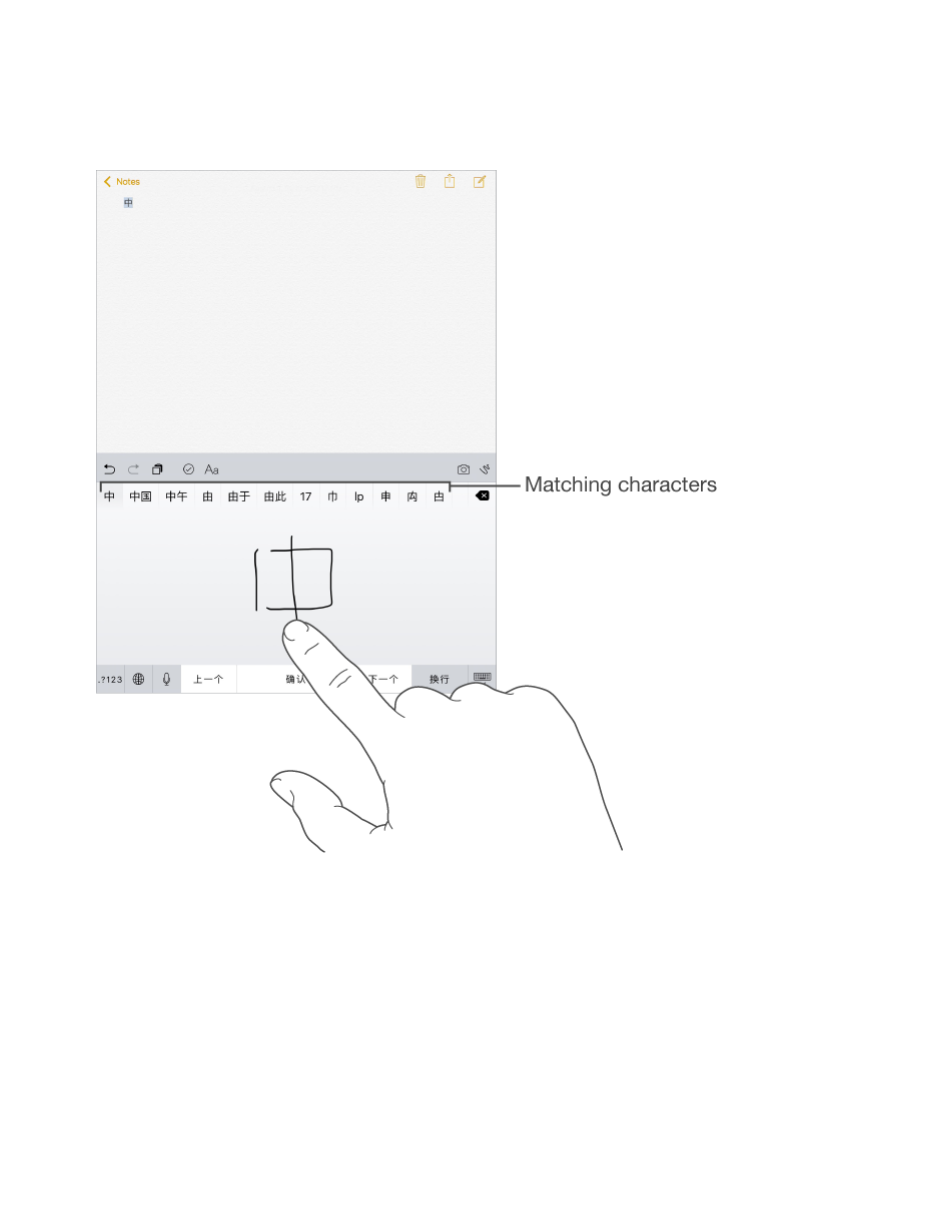
Write Chinese characters.
Write Chinese characters directly on the screen with your finger when Simplified
or Traditional Chinese handwriting input is turned on. As you write character
strokes, iPad recognizes them and shows matching characters in a list, with the
closest match at the top. When you choose a character, its likely follow-on
characters appear in the list as additional choices.
You can type some complex characters, such as 鱲 (part of the name for the
Hong Kong International Airport), by writing two or more component characters
in sequence. Tap the character to replace the characters you typed. Roman
characters are also recognized.
Type Japanese kana.
Use the Kana keypad to select syllables. For more syllable options, tap the
arrow key and select another syllable or word from the window.
Type Japanese romaji.
Use the Romaji keyboard to type syllables. Alternative choices appear along the
top of the keyboard; tap one to type it. For more syllable options, drag the list to
the left or tap the arrow key.
Type facemarks or emoticons.
Apple Confidential
217

Use the Japanese Kana keyboard and tap the key. Or you can:
Use the Japanese Romaji keyboard (QWERTY-Japanese layout): Tap
, then tap the key.
Use the Chinese (Simplified or Traditional) Pinyin or (Traditional) Zhuyin
keyboard: Tap , then tap the key.
HomeKit
HomeKit basics
With HomeKit, you can use iPad to control any “Works with Apple HomeKit”
accessory that you have in your home, such as lights, locks, thermostats, smart
plugs, and more.
HomeKit allows you to create commands or scenes to control home settings.
For example, you can create a scene to turn off the lights, lock the doors, close
the garage door, and set the thermostat to the desired temperature, all with one
command. HomeKit also provides an easy, secure way to control HomeKit-
enabled accessories using Siri.
HomeKit is organized around three types of locations: homes, rooms, and
zones. Each home contains rooms, such as “bedroom,” and you can group
rooms into zones, such as “upstairs.”
Apple Confidential
218

Setting up a home and Users
Defining a home allows HomeKit-enabled apps and accessories from different
manufacturers to work together. It’s the first thing you should do when getting
started with HomeKit.
Define a home.
Use the app that works with your HomeKit-enabled accessory to define a home.
The process varies, depending on the app and accessory, but generally you will
pair the accessory with iPad by entering the accessory’s HomeKit setup code in
the accessory’s app. If this is your first accessory, a Home will be created for
you.
Adding a second home.
As described above, use a HomeKit-enabled app to define an additional home.
Give others control.
To let others control your accessories using their iOS devices, go to Settings >
Home, then tap Invite People. They need an iCloud account to join your home.
People you invite can control your accessories, but they can’t add new ones.
Control your home away from home.
If you have an Apple TV (3rd generation or later) with software version 7.0 or
later, or a HomeKit accessory that supports iCloud Remote Access, this allows
you to securely control your home when you’re away. Go to Settings > Home,
then turn on Allow Remote Access. Make sure you’re signed in with the same
iCloud account on both iPad and Apple TV.
Define rooms, zones and scenes.
Use your HomeKit-enabled apps to assign accessories to rooms, and rooms to
zones. Many apps also allow you to define scenes. Once these items are
defined, you can control with them Siri, as described below.
Reset your home data.
To delete all of your home data from iPad and iCloud, go to Settings > Privacy >
HomeKit, then tap Reset HomeKit Configuration.
For more information about HomeKit-enabled accessories and other info, see:
support.apple.com/HT204893
Control HomeKit accessories using Siri
You can use Siri to control the HomeKit-enabled accessories you have
configured. Here are some of the things you might be able to say to Siri,
depending on your accessories:
“Turn off the lights” or “Turn on the lights”
“Dim the lights” or “Set brightness to 55%”
“Turn on the coffee maker”
“Set the temperature to 68 degrees”
If you’ve set up rooms, zones, scenes, or homes you can say things like:
Apple Confidential
219

“Turn down the kitchen lights”
“Turn on the printer in the office”
“Turn off the upstairs lights”
“Set my reading scene”
“Set the temperature in the Chicago house to 72 degrees”
Safety, handling, and support
Important safety information
WARNING: Failure to follow these safety instructions could result in fire, electric
shock, injury, or damage to iPad or other property. Read all the safety
information below before using iPad.
Handling Handle iPad with care. It is made of metal, glass, and plastic and has
sensitive electronic components inside. iPad can be damaged if dropped,
burned, punctured, or crushed, or if it comes in contact with liquid. Don’t use a
damaged iPad, such as one with a cracked screen, as it may cause injury. If
you’re concerned about scratching, consider using a case or cover.
Repairing Don’t open iPad and don’t attempt to repair iPad yourself.
Disassembling iPad may damage it or may cause injury to you. If iPad is
damaged, malfunctions, or comes in contact with liquid, contact Apple or an
Apple Authorized Service Provider. You can find more information about getting
service at www.apple.com/support/ipad/repair/.
Battery Don’t attempt to replace the iPad battery yourself—you may damage
the battery, which could cause overheating and injury. The lithium-ion battery in
iPad should be replaced by Apple or an authorized service provider, and must
be recycled or disposed of separately from household waste. Don’t incinerate
Apple Confidential
220

the battery. For information about battery services and recycling, go to
www.apple.com/batteries/service-and-recycling/.
Distraction Using iPad in some circumstances may distract you and might
cause a dangerous situation (for example, avoid using headphones while riding
a bicycle and avoid typing a text message while driving a car). Observe rules
that prohibit or restrict the use of mobile devices or headphones.
Navigation Maps, directions, Flyover, and location-based apps depend on data
services. These data services are subject to change and may not be available in
all areas, resulting in maps, directions, Flyover, or location-based information
that may be unavailable, inaccurate, or incomplete. Some Maps features require
Location Services. Compare the information provided on iPad to your
surroundings and defer to posted signs to resolve any discrepancies. Do not use
these services while performing activities that require your full attention. Always
comply with posted signs and the laws and regulations in the areas where you
are using iPad and always use common sense.
Charging Charge iPad with the included USB cable and power adapter, or with
other third-party “Made for iPad” cables and power adapters that are
compatible with USB 2.0 or later, or power adapters compliant with applicable
country regulations and with one or more of the following standards: EN
301489-34, IEC 62684, YD/T 1591-2009, CNS 15285, ITU L.1000, or another
applicable mobile phone power adapter interoperability standard.
Using damaged cables or chargers, or charging when moisture is present, can
cause fire, electric shock, injury, or damage to iPad or other property. When you
use the Apple USB Power Adapter to charge iPad, make sure the USB cable is
fully inserted into the power adapter before you plug the adapter into a power
outlet.
Lightning cable and connector Avoid prolonged skin contact with the
connector when the Lightning to USB Cable is plugged into a power source
because it may cause discomfort or injury. Sleeping or sitting on the Lightning
connector should be avoided.
Prolonged heat exposure iPad and its power adapter comply with applicable
surface temperature standards and limits. However, even within these limits,
sustained contact with warm surfaces for long periods of time may cause
discomfort or injury. Use common sense to avoid situations where your skin is in
contact with a device or its power adapter when it’s operating or plugged into a
power source for long periods of time. For example, don’t sleep on a device or
power adapter, or place them under a blanket, pillow, or your body, when it’s
plugged into a power source. It’s important to keep iPad and its power adapter
in a well-ventilated area when in use or charging. Take special care if you have a
physical condition that affects your ability to detect heat against the body.
Hearing loss Listening to sound at high volumes may damage your hearing.
Background noise, as well as continued exposure to high volume levels, can
make sounds seem quieter than they actually are. Turn on audio playback and
check the volume before inserting anything in your ear. For more information
about hearing loss, see www.apple.com/sound/. For information about how to
set a maximum volume limit on iPad, see Music settings (on page) .
To avoid hearing damage, use only compatible receivers, earbuds, headphones,
speakerphones, or earpieces with iPad. The headsets sold with iPhone 4s or
Apple Confidential
221

later in China (identifiable by dark insulating rings on the plug) are designed to
comply with Chinese standards and are only compatible with iPhone 4s or later,
iPad 2 or later, and iPod touch 5th generation.
WARNING: To prevent possible hearing damage, do not listen at high volume
levels for long periods.
Radio frequency exposure iPad uses radio signals to connect to wireless
networks. For information about radio frequency (RF) energy resulting from radio
signals and steps you can take to minimize exposure, go to Settings > General >
About > Legal > RF Exposure or visit www.apple.com/legal/rfexposure/.
Radio frequency interference Observe signs and notices that prohibit or
restrict the use of mobile devices (for example, in healthcare facilities or blasting
areas). Although iPad is designed, tested, and manufactured to comply with
regulations governing radio frequency emissions, such emissions from iPad can
negatively affect the operation of other electronic equipment, causing them to
malfunction. Turn off iPad or use Airplane Mode to turn off the iPad wireless
transmitters when use is prohibited, such as while traveling in aircraft, or when
asked to do so by authorities.
Medical device interference iPad contains components and radios that emit
electromagnetic fields. iPad also contains magnets along the left edge of the
device and on the right side of the front glass, which may interfere with
pacemakers, defibrillators, or other medical devices. The iPad Smart Cover and
iPad Smart Case also contain magnets. These electromagnetic fields and
magnets may interfere with pacemakers, defibrillators, or other medical devices.
Maintain a safe distance of separation between your medical device and iPad,
the iPad Smart Cover, and the iPad Smart Case. Consult your physician and
medical device manufacturer for information specific to your medical device. If
you suspect iPad is interfering with your pacemaker, defibrillator, or any other
medical device, stop using iPad.
Not a medical device iPad is not designed or intended for use in the diagnosis
of disease or other conditions, or in the cure, mitigation, treatment, or prevention
of disease.
Medical conditions If you have any medical condition that you believe could
be affected by iPad (for example, seizures, blackouts, eyestrain, or headaches),
consult with your physician prior to using iPad.
Explosive atmospheres Charging or using iPad in any area with a potentially
explosive atmosphere, such as areas where the air contains high levels of
flammable chemicals, vapors, or particles (such as grain, dust, or metal
powders), may be hazardous. Obey all signs and instructions.
Repetitive motion When you perform repetitive activities such as typing or
playing games on iPad, you may experience discomfort in your hands, arms,
wrists, shoulders, neck, or other parts of your body. If you experience
discomfort, stop using iPad and consult a physician.
High-consequence activities This device is not intended for use where the
failure of the device could lead to death, personal injury, or severe environmental
damage.
Choking hazard Some iPad accessories may present a choking hazard to
small children. Keep these accessories away from small children.
Apple Confidential
222

Important handling information
Cleaning Clean iPad immediately if it comes in contact with anything that may
cause stains—such as dirt, ink, makeup, or lotions. To clean:
Disconnect all cables and turn iPad off (press and hold the Sleep/Wake
button, then slide the onscreen slider).
Use a soft, lint-free cloth.
Avoid getting moisture in openings.
Don’t use cleaning products or compressed air.
The front of iPad is made of glass with a fingerprint-resistant oleophobic (oil
repellant) coating. This coating wears over time with normal usage. Cleaning
products and abrasive materials will further diminish the coating, and may
scratch the glass.
Using connectors, ports, and buttons Never force a connector into a port or
apply excessive pressure to a button, because this may cause damage that is
not covered under the warranty. If the connector and port don’t join with
reasonable ease, they probably don’t match. Check for obstructions and make
sure that the connector matches the port and that you have positioned the
connector correctly in relation to the port.
Lightning to USB Cable Discoloration of the Lightning connector after regular
use is normal. Dirt, debris, and exposure to moisture may cause discoloration. If
your Lightning cable or connector become warm during use or your iPad won’t
charge or sync, disconnect it from your computer or power adapter and clean
the Lightning connector with a soft, dry, lint-free cloth. Do not use liquids or
cleaning products when cleaning the Lightning connector.
Certain usage patterns can contribute to the fraying or breaking of cables. The
Lightning to USB Cable, like any other metal wire or cable, is subject to
becoming weak or brittle if repeatedly bent in the same spot. Aim for gentle
curves instead of angles in the cable. Regularly inspect the cable and connector
for any kinks, breaks, bends, or other damage. Should you find any such
damage, discontinue use of the Lightning to USB Cable.
Operating temperature iPad is designed to work in ambient temperatures
between 32° and 95° F (0° and 35° C) and stored in temperatures between -4°
and 113° F (-20° and 45° C). iPad can be damaged and battery life shortened if
stored or operated outside of these temperature ranges. Avoid exposing iPad to
dramatic changes in temperature or humidity. When you’re using iPad or
charging the battery, it is normal for iPad to get warm.
If the interior temperature of iPad exceeds normal operating temperatures (for
example, in a hot car or in direct sunlight for extended periods of time), you may
experience the following as it attempts to regulate its temperature:
iPad stops charging.
The screen dims.
A temperature warning screen appears.
Some apps may close.
Important: You may not be able to use iPad while the temperature warning
screen is displayed. If iPad can’t regulate its internal temperature, it goes into
Apple Confidential
223

deep sleep mode until it cools. Move iPad to a cooler location out of direct
sunlight and wait a few minutes before trying to use iPad again.
For more information, see support.apple.com/HT201678.
iPad Support site
Comprehensive support information is available online at
www.apple.com/support/ipad/. To contact Apple for personalized support (not
available in all areas), see www.apple.com/support/contact/.
Restart or reset iPad
If something isn’t working right, try restarting iPad, forcing an app to quit, or
resetting iPad.
Restart iPad.
Hold down the Sleep/Wake button until the slider appears. Slide your finger
across the slider to turn off iPad. To turn iPad back on, hold down the
Sleep/Wake button until the Apple logo appears.
Force an app to quit.
Hold down the Sleep/Wake button on top of iPad for a few seconds until a red
slider appears, then hold down the Home button until the app closes.
If you can’t turn off iPad or if the problem continues, you may need to reset
iPad. Do this only if you’re unable to restart iPad.
Reset iPad.
Hold down the Sleep/Wake button and the Home button at the same time for at
least ten seconds, until the Apple logo appears.
You can reset the word dictionary, network settings, home screen layout, and
location warnings. You can also erase all of your content and settings.
Reset iPad settings
Reset iPad settings.
Go to Settings > General > Reset, then choose an option:
Reset All Settings: All your preferences and settings are reset.
Erase All Content and Settings: Your information and settings are removed.
iPad cannot be used until it’s set up again.
Reset Network Settings: When you reset network settings, previously used
networks and VPN settings that weren’t installed by a configuration profile are
removed. (To remove VPN settings installed by a configuration profile, go to
Settings > General > Profile, select the profile, then tap Remove. This also
removes other settings or accounts provided by the profile.) Wi-Fi is turned
Apple Confidential
224

off and then back on, disconnecting you from any network you’re on. The Wi-
Fi and “Ask to Join Networks” settings remain turned on.
Reset Keyboard Dictionary: You add words to the keyboard dictionary by
rejecting words iPad suggests as you type. Resetting the keyboard dictionary
erases all words you’ve added.
Reset Home Screen Layout: Returns the built-in apps to their original layout
on the Home screen.
Reset Location & Privacy: Resets the location services and privacy settings
to their defaults.
An app doesn’t fill the screen
Most apps for iPhone and iPod touch can be used with iPad, but they might not
take advantage of the large screen. In this case, tap to zoom in on the
app. Tap to return to the original size.
Check the App Store to see if there’s a version of the app that’s optimized for
iPad, or a universal version that’s optimized for iPhone, iPod touch, and iPad.
Onscreen keyboard doesn’t appear
If iPad is paired with a Bluetooth keyboard, the onscreen keyboard doesn’t
appear. To make the onscreen keyboard appear, press the Eject key on a
Bluetooth keyboard. You can also make the onscreen keyboard appear by
moving the Bluetooth keyboard out of range or turning it off.
Get information about your iPad
See information about iPad.
Go to Settings > General > About. The items you can view include:
Name
Network
Number of songs, videos, photos, and apps
Capacity and available storage space
iOS version
(Cellular models) Carrier
Model number
Serial number
Apple Confidential
225

(Cellular models) Cellular Data Number
Wi-Fi and Bluetooth addresses
(Cellular models) IMEI (International Mobile Equipment Identity)
(Cellular models) ICCID (Integrated Circuit Card Identifier, or Smart Card) for
GSM networks
(Cellular models) MEID (Mobile Equipment Identifier) for CDMA networks
Modem firmware
Legal (including legal notices, and license, warranty, and RF exposure
information)
To copy the serial number and other identifiers, touch and hold the identifier until
Copy appears.
To see regulatory marks, go to Settings > General > Regulatory.
View or turn off diagnostic information.
Go to Settings > Privacy > Diagnostics & Usage.
To help Apple improve products and services, iPad sends diagnostic and usage
data. This data doesn’t personally identify you, but may include location
information.
Usage information
View cellular usage.
Go to Settings > Cellular Data. See Cellular settings (on page) .
View other usage information.
Go to Settings > General > Usage to:
See Battery Usage, including the elapsed time since iPad has been charged
and usage by app
Display battery level as a percentage
View overall storage availability and storage used per app
View and manage iCloud storage
Disabled iPad
If iPad is disabled because you forgot your passcode or entered an incorrect
passcode too many times, you can restore iPad from an iTunes or iCloud
backup and reset the passcode. For more information, see Restore iPad (on
page) .
If you get a message in iTunes that your iPad is locked and you must enter a
passcode, see support.apple.com/HT204306.
Apple Confidential
226

VPN settings
A VPN (virtual private network) provides secure access over the Internet to
private networks, such as the network at your organization. You may need to
install a VPN app from the App Store that configures iPad to access a network.
Contact your system administrator for information about the app and settings
you need.
Profiles settings
Configuration profiles define settings for using iPad with corporate or school
networks or accounts. You might be asked to install a configuration profile that
was sent to you in an email, or one that is downloaded from a webpage. iPad
asks for your permission to install the profile, and displays information about
what it contains, when you open the file. You can see the profiles you have
installed in Settings > General > Profiles. If you delete a profile, all of the
settings, apps, and data associated with the profile are also deleted.
Back up iPad
You can use iCloud or iTunes to automatically back up iPad. If you choose to
back up using iCloud, you can’t also use iTunes to automatically back up to your
computer, but you can use iTunes to manually back up to your computer. iCloud
backs up iPad daily over Wi-Fi, when it’s connected to a power source and is
locked. The date and time of the last backup is listed at the bottom of the
Backup screen.
iCloud backs up your:
Purchased music, movies, TV shows, apps, and books
Photos and videos taken with iPad (if you use iCloud Photo Library, your
photos and videos are already stored in iCloud, so they won’t also be part of
an iCloud backup)
iPad settings
App data
Home screen, folders, and app layout
Messages
Ringtones
Note: Purchased content is not backed up in all areas.
Turn on iCloud backups.
Go to Settings > iCloud, then log in with your Apple ID and password if required.
Go to Backup, then turn on iCloud Backup. To turn on backups in iTunes on
your computer, go to File > Devices > Back Up.
Back up immediately.
Go to Settings > iCloud > Backup, then tap Back Up Now.
Apple Confidential
227

Encrypt your backup.
iCloud backups are encrypted automatically so that your data is protected from
unauthorized access both while it’s transmitted to your devices and when it’s
stored in iCloud. If you’re using iTunes for your backup, select “Encrypt iPad
backup” in the iTunes Summary pane.
Manage your backups.
Go to Settings > iCloud. You can manage which apps are backed up to iCloud
by tapping them on or off. Go to Settings > iCloud > Storage > Manage Storage
to remove existing backups and manage iCloud Drive or Documents & Data. In
iTunes, remove backups in iTunes Preferences.
View the devices being backed up.
Go to Settings > iCloud > Storage > Manage Storage.
Stop iCloud backups.
Go to Settings > iCloud > Backup, then turn off iCloud Backup.
Music not purchased in iTunes isn’t backed up in iCloud. Use iTunes to back up
and restore that content. See Sync with iTunes (on page) .
Important: Backups for music, movies, or TV show purchases are not available
in all countries. Previous purchases may not be restored if they are no longer in
the iTunes Store, App Store, or iBooks Store.
Purchased content, iCloud Photo Sharing, and My Photo Stream content don’t
count against your 5 GB of free iCloud storage.
For more information about backing up iPad, see support.apple.com/HT204136.
Update and restore iPad software
About update and restore
You can update iPad software in Settings, or by using iTunes. You can also erase
iPad or restore iPad, and then use iCloud or iTunes to restore from a backup.
Deleted data is no longer accessible through the iPad user interface, but it isn’t
erased from iPad. For information about erasing all content and settings, see
Restart or reset iPad (on page) .
Update iPad
You can update iPad software in Settings or by using iTunes.
Update wirelessly on iPad.
Go to Settings > General > Software Update. iPad checks for available software
updates.
Update software in iTunes.
iTunes checks for available software updates each time you sync iPad using
iTunes. See Sync with iTunes (on page) .
For more information about updating iPad software, see
support.apple.com/HT204204.
Apple Confidential
228

Restore iPad
You can use iCloud or iTunes to restore iPad from a backup.
Restore from an iCloud backup.
Reset iPad to erase all content and settings, then choose Restore from a
Backup and sign in to iCloud in Setup Assistant. See Restart or reset iPad (on
page) .
Restore from an iTunes backup.
Connect iPad to the computer you normally sync with, select iPad in the iTunes
window, then click Restore in the Summary pane.
When the iPad software is restored, you can either set it up as a new iPad, or
restore your music, videos, app data, and other content from a backup.
For more information about restoring iPad software, see
support.apple.com/HT201252.
Cellular settings
Use Cellular Data settings on iPad (Wi-Fi + Cellular models) to activate cellular
data service, turn cellular use on or off, or add a Personal Identification Number
(PIN) to lock the SIM card. With some carriers, you can also change your data
plan.
For the following options, go to Settings > Cellular Data, then turn the options
on or off, or follow the onscreen instructions.
Turn Cellular Data on or off.
If Cellular Data is off, all data services will use only Wi-Fi—including email, web
browsing, push notifications, and other services. If Cellular Data is on, carrier
charges may be incurred. For example, using certain features and services that
transfer data, such as Messages, could result in charges to your data plan.
Monitor and manage your cellular data network usage.
You can see which apps use cellular data and turn off the option, if you want.
Turn LTE on or off.
Turning on LTE loads data faster.
Turn Data Roaming on or off.
Turning off Data Roaming avoids carrier charges when using a network provided
by a different carrier.
Set up Personal Hotspot.
Personal Hotspot shares iPad’s Internet connection with your computer and
other iOS devices. See Personal Hotspot (on page) .
Set whether cellular data is used for apps and services.
Go to Settings > Cellular, then turn cellular data on or off for any app that can
use cellular data. If a setting is off, iPad uses only Wi-Fi for that service. The
iTunes setting includes both iTunes Match and automatic downloads from the
iTunes Store and the App Store.
Apple Confidential
229

Activate, view, or change your cellular data account.
Tap View Account, then follow the onscreen instructions.
Lock the SIM card.
Locking the SIM card with a PIN means you need to enter the PIN to use a
cellular connection on iPad.
Sell or give away iPad
Before you sell or give away your iPad, be sure to back it up, then erase all
content and your personal information. If you enabled Find My iPad (see Find
My iPad (on page) ), Activation Lock is on. You need to turn off Activation Lock
before the new owner can activate iPad under his or her own account.
Back up iPad.
See Back up iPad.
Erase iPad and remove Activation Lock.
Go to Settings > General > Reset > Erase All Content and Settings.
See support.apple.com/HT201351.
Learn more, service, and support
Refer to the following resources to get more iPad-related safety, software,
service, and support information.
To learn about
Do this
Using iPad safely See Important safety information (on
page) .
iPad service and support, tips,
forums, and Apple software
downloads
Go to www.apple.com/support/ipad/.
The latest information about iPad Go to www.apple.com/ipad/.
Managing your Apple ID account Go to appleid.apple.com.
Using iCloud Go to help.apple.com/icloud/.
Using iTunes Open iTunes, then choose Help >
iTunes Help. For an online iTunes
tutorial (not available in all areas), go to
www.apple.com/support/itunes/.
Using other Apple iOS apps Go to www.apple.com/support/ios/.
Finding your iPad serial number or You can find your iPad serial number or
Apple Confidential
230

IMEI International Mobile Equipment Identity
(IMEI) on the iPad packaging. Or, on
iPad, choose Settings > General >
About. For more information, go to
support.apple.com/HT204073.
Obtaining warranty service First follow the advice in this guide.
Then go to
www.apple.com/support/ipad/.
Viewing iPad regulatory information On iPad, go to Settings > General >
Regulatory.
Battery service Go to
www.apple.com/batteries/service-and-
recycling/.
Using iPad in an enterprise
environment
Go to www.apple.com/ipad/business/.
FCC compliance statement
This device complies with part 15 of the FCC rules. Operation is subject to the
following two conditions: (1) This device may not cause harmful interference,
and (2) this device must accept any interference received, including interference
that may cause undesired operation.
Note: This equipment has been tested and found to comply with the limits for a
Class B digital device, pursuant to part 15 of the FCC Rules. These limits are
designed to provide reasonable protection against harmful interference in a
residential installation. This equipment generates, uses, and can radiate radio
frequency energy and, if not installed and used in accordance with the
instructions, may cause harmful interference to radio communications. However,
there is no guarantee that interference will not occur in a particular installation. If
this equipment does cause harmful interference to radio or television reception,
which can be determined by turning the equipment off and on, the user is
encouraged to try to correct the interference by one or more of the following
measures:
Reorient or relocate the receiving antenna.
Increase the separation between the equipment and receiver.
Connect the equipment to an outlet on a circuit different from that to which
the receiver is connected.
Consult the dealer or an experienced radio/TV technician for help.
Important: Changes or modifications to this product not authorized by Apple
could void the electromagnetic compatibility (EMC) and wireless compliance
and negate your authority to operate the product. This product has
demonstrated EMC compliance under conditions that included the use of
compliant peripheral devices and shielded cables between system components.
Apple Confidential
231

It is important that you use compliant peripheral devices and shielded cables
between system components to reduce the possibility of causing interference to
radios, televisions, and other electronic devices.
Canadian regulatory statement
This device complies with Industry Canada licence-exempt RSS standard(s).
Operation is subject to the following two conditions: (1) this device may not
cause interference, and (2) this device must accept any interference, including
interference that may cause undesired operation of the device.
Operation in the band 5150-5250 MHz is only for indoor use to reduce the
potential for harmful interference to co-channel mobile satellite systems.
Users are advised that high-power radars are allocated as primary users (i.e.,
priority users) of the bands 5250-5350 MHz and 5650-5850 MHz and that these
radars could cause interference and/or damage to LE-LAN devices.
Le présent appareil est conforme aux CNR d’Industrie Canada applicables aux
appareils radio exempts de licence. L’exploitation est autorisée aux deux
conditions suivantes : (1) l’appareil ne doit pas produire de brouillage, et (2)
l’utilisateur de l’appareil doit accepter tout brouillage radioélectrique subi, même
si le brouillage est susceptible d’en compromettre le fonctionnement.
La bande 5 150-5 250 MHz est réservés uniquement pour une utilisation à
l’intérieur afin de réduire les risques de brouillage préjudiciable aux systèmes de
satellites mobiles utilisant les mêmes canaux.
Les utilisateurs êtes avisés que les utilisateurs de radars de haute puissance
sont désignés utilisateurs principaux (c.-à-d., qu’ils ont la priorité) pour les
bandes 5 250-5 350 MHz et 5 650-5 850 MHz et que ces radars pourraient
causer du brouillage et/ou des dommages aux dispositifs LAN-EL.
CAN ICES-3 (B)/NMB-3(B)
Disposal and recycling information
Your iPad and/or battery should not be disposed of with household waste.
Dispose of your iPad and/or battery in accordance with local environmental laws
and guidelines. For information about the recycling program at Apple and
recycling collection points, visit www.apple.com/recycling. For information about
restricted substances and other environmental initiatives at Apple, visit
www.apple.com/environment/.
Battery replacement: The lithium-ion battery in iPad should be replaced by
Apple or an authorized service provider. For more information about battery
services and recycling, go to www.apple.com/batteries/service-and-recycling/.
European Union—Disposal Information
Apple Confidential
232

The symbol above means that according to local laws and regulations your
product and/or its battery shall be disposed of separately from household
waste. When this product reaches its end of life, take it to a collection point
designated by local authorities. The separate collection and recycling of your
product and/or its battery at the time of disposal will help conserve natural
resources and ensure that it is recycled in a manner that protects human health
and the environment.
Union Européenne—informations sur l’élimination: Le symbole ci-dessus
signifie que, conformément aux lois et réglementations locales, vous devez
jeter votre produit et/ou sa batterie séparément des ordures ménagères.
Lorsque ce produit arrive en fin de vie, apportez-le à un point de collecte
désigné par les autorités locales. La collecte séparée et le recyclage de votre
produit et/ou de sa batterie lors de sa mise au rebut aideront à préserver les
ressources naturelles et à s’assurer qu’il est recyclé de manière à protéger la
santé humaine et l’environnement.
Europäische Union—Informationen zur Entsorgung: Das oben aufgeführte
Symbol weist darauf hin, dass dieses Produkt und/oder die damit verwendete
Batterie den geltenden gesetzlichen Vorschriften entsprechend und vom
Hausmüll getrennt entsorgt werden muss. Geben Sie dieses Produkt zur
Entsorgung bei einer offiziellen Sammelstelle ab. Durch getrenntes Sammeln
und Recycling werden die Rohstoffreserven geschont und es ist sichergestellt,
dass beim Recycling des Produkts und/oder der Batterie alle Bestimmungen
zum Schutz von Gesundheit und Umwelt eingehalten werden.
Unione Europea—informazioni per lo smaltimento: Il simbolo qui sopra
significa che, in base alle leggi e alle normative locali, il prodotto e/o la sua
batteria dovrebbero essere riciclati separatamente dai rifiuti domestici. Quando
il prodotto diventa inutilizzabile, portalo nel punto di raccolta stabilito dalle
autorità locali. La raccolta separata e il riciclaggio del prodotto e/o della sua
batteria al momento dello smaltimento aiutano a conservare le risorse naturali e
assicurano che il riciclaggio avvenga nel rispetto della salute umana e
dell’ambiente.
Per i consumatori italiani: quando si acquista un nuovo prodotto Apple, é
possibile restituire un prodotto elettronico simile presso il punto vendita senza
costi aggiuntivi. Nel caso in cui si tratti di di dispositivi mobili e piccoli
accessori, é possibile restituirli al punto vendita in qualsiasi momento. Per
maggiori informazioni, consulta la pagina http://www.apple.com/it/recycling.
Europeiska unionen—information om kassering: Symbolen ovan betyder
att produkten och/eller dess batteri enligt lokala lagar och bestämmelser inte
får kastas tillsammans med hushållsavfallet. När produkten har tjänat ut måste
den tas till en återvinningsstation som utsetts av lokala myndigheter. Genom att
låta den uttjänta produkten och/eller dess batteri tas om hand för återvinning
hjälper du till att spara naturresurser och skydda hälsa och miljö.
Brasil—Informações sobre descarte e reciclagem
Apple Confidential
233

O símbolo indica que este produto e/ou sua bateria não devem ser descartadas
no lixo doméstico. Quando decidir descartar este produto e/ou sua bateria,
faça-o de acordo com as leis e diretrizes ambientais locais. Para informações
sobre o programa de reciclagem da Apple, pontos de coleta e telefone de
informações, visite www.apple.com/br/environment/.
Información sobre eliminación de residuos y reciclaje
El símbolo indica que este producto y/o su batería no debe desecharse con los
residuos domésticos. Cuando decida desechar este producto y/o su batería,
hágalo de conformidad con las leyes y directrices ambientales locales. Para
obtener información sobre el programa de reciclaje de Apple, puntos de
recolección para reciclaje, sustancias restringidas y otras iniciativas
ambientales, visite www.apple.com/la/environment/.
California battery charger energy efficiency
Turkey battery statement
Türkiye Cumhuriyeti: AEEE Yönetmeliğine Uygundur.
Taiwan battery statement
China battery statement
ENERGY STAR® compliance statement
Apple Confidential
234

To save energy, iPad is set to lock after two minutes of user inactivity. To change
this setting, go to Settings > General > Auto-Lock. To unlock iPad, press the
Sleep/Wake button or the Home button.
iPad meets the ENERGY STAR guidelines for energy efficiency. Reducing energy
consumption saves money and helps conserve valuable resources. For more
information about ENERGY STAR, go to www.energystar.gov.
Apple and the environment
At Apple, we recognize our responsibility to minimize the environmental impacts
of our operations and products. For more information, go to
www.apple.com/environment/.
Copyright
Apple Inc.
© 2015 Apple Inc. All rights reserved.
Apple, the Apple logo, AirDrop, AirPlay, AirPort, Apple TV, FaceTime, Finder,
GarageBand, Guided Access, iBooks, iCloud Keychain, iMessage, iPad,
iPad Air, iPhone, iPhoto, iPod, iPod touch, iSight, iTunes, iTunes U, Keychain,
Keynote, Lightning, Mac, Numbers, OS X, Pages, Passbook, Photo Booth, the
Podcast logo, Safari, Siri, Smart Cover, and Spotlight are trademarks of Apple
Inc., registered in the U.S. and other countries.
AirPrint, Apple Music, Apple Pay, EarPods, Flyover, Handoff, iPad mini, Multi-
Touch, and Touch ID are trademarks of Apple Inc.
Apple Store, iCloud, iTunes Extras, iTunes Match, iTunes Plus, and iTunes Store
are service marks of Apple Inc., registered in the U.S. and other countries.
Apple
1 Infinite Loop
Cupertino, CA 95014-2084
408-996-1010
www.apple.com
App Store, iBooks Store, and iTunes Radio are service marks of Apple Inc.
IOS is a trademark or registered trademark of Cisco in the U.S. and other
countries and is used under license.
The Bluetooth® word mark and logos are registered trademarks owned by
Bluetooth SIG, Inc. and any use of such marks by Apple Inc. is under license.
ENERGY STAR® is a U.S. registered trademark.
Adobe and Photoshop are trademarks or registered trademarks of Adobe
Systems Incorporated in the U.S. and/or other countries.
Other company and product names mentioned herein may be trademarks of
their respective companies.
Apple Confidential
235

Every effort has been made to ensure that the information in this manual is
accurate. Apple is not responsible for printing or clerical errors.
Some apps are not available in all areas. App availability is subject to change.
Apple Confidential
236